Click on the button to load the content from www.googletagmanager.com.
Load content

- Tailored Vacation Planner
- Cabin Yacht Charter
- Family Sailing Holidays
- Romantic Sailing Vacations For Couples
- Sailing with friends
- Greece all inclusive yacht charter
- Croatia all inclusive yacht charter
- Food & Wine Routes
- Yacht search
- Luxury sailing

Boat vs. Ship vs Yacht: What’s the Difference?
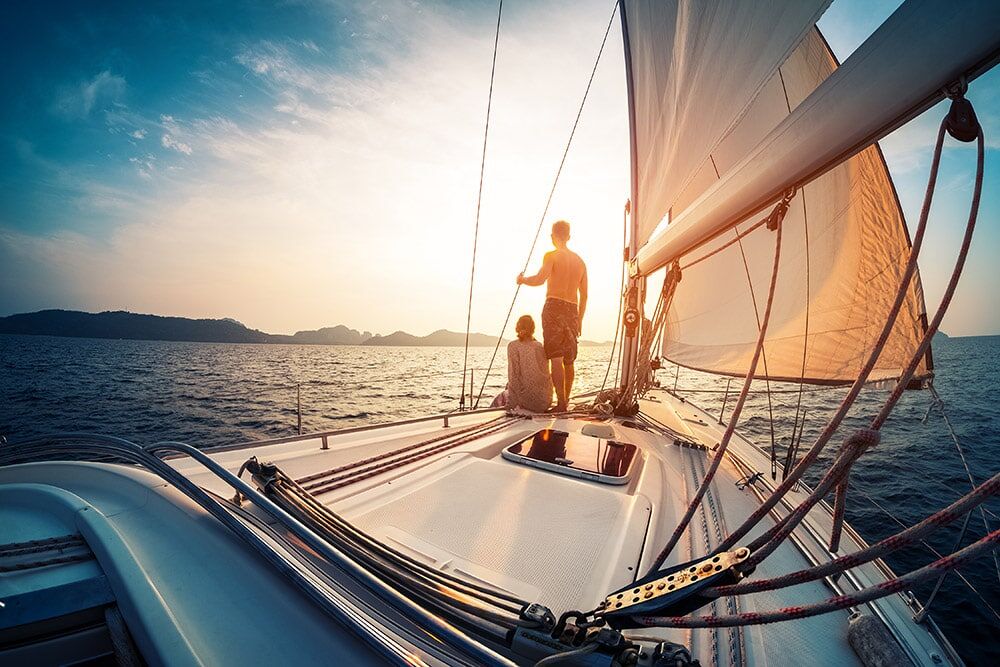
Language is a tricky thing, and picking out the differences between similar terms can be confusing. This is especially true when some of the definitions overlap. This is the case with the case of boat vs. ship vs. yacht . What’s the difference? We know in our gut that there are differences between these three seafaring vessels, but unless you’re a harbor master do you really know what counts as what?
Let’s get into some definitions, and we’re going to start with the easiest to explain: What is a yacht? What is a ship? And what is a boat?
Yacht vs. Ship vs. Boat
What is a yacht.
A yacht, I think everyone would agree, is fancier than a ship or a boat. “Yacht” infers some amount of luxury , and definitely recreation. There’s also something to be said about size. A yacht tends to be anywhere between 35 feet up to 160 feet. And some yachts, known as superyachts, go even beyond that. (Jeff Bezos just built a 417 foot yacht, but that’s really breaking yacht records.)
Because of the size, yachts tend to operate in larger bodies of water–generally the ocean. Yachts are able to handle rougher ocean waves, and they are also equipped with more advanced navigation and guidance instruments than smaller boats. Likewise, a yacht tends to have a full crew to help with the navigation, engineering, repairs, as well as having stewards that serve the yacht’s guests. This can be anywhere from a crew of four or five up to a crew of a few dozen on large yachts.
One interesting thing to note is that outside of the United States, a yacht refers to a sailboat , and a motorized yacht is called a “motor yacht”.
So, is a yacht a boat? Yes, technically a yacht is a boat. But a yacht is a very specific kind of boat.
Want to hop aboard?
Book your dream sailing vacation in top sailing destinations!
- Explore your charter options
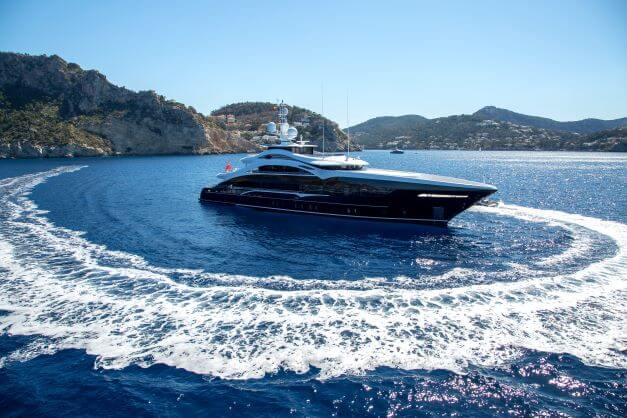
What is a Ship?
The term ship is most commonly associated with a very large boat, and something that is not as fancy as a yacht (one exception is that cruise ships can still be very fancy, but are referred to as ships because of their size and power.)
Ships are generally so large that they would never be found in a lake, with some exceptions for the Great Lakes, and are made for navigating the high seas of the open ocean. An ship can refer to a cruise ship, a naval ship, a tanker, a container ship, and many other commercial vessels.
Ships tend to have advanced navigation and technology, but much more advanced than that of a yacht due to the size, the speed, and the routes that a ship will take. They are meant to be traversing the open ocean for very long periods of time, from one continent to the next, while a yacht may only rarely set across the ocean and most often stays somewhat near land.
A ship will also have a much larger crew than a yacht or a boat. Ships are typically so large that they need not only one trained navigator but a set of navigators, plus an entire engineering team, and includes many more positions.
Finally, a ship is meant to carry things. This may be passengers, yes (in reference to cruise ships and some navy ships) but most ships are for carrying cargo–or even carrying equipment to do work on other ships including repair work or refueling.
What is a Boat?
Well, a boat is harder to define, because a yacht is technically a boat, and a ship is technically a boat. But when people refer to boats, they are almost always referring to something smaller than either a yacht or a ship. Boats may be motorized, like a speed boat, or they may sail, or they may be man-powered, like a rowboat or a kayak. Really, anything up to and including a liferaft, can be called a boat.
(As a side note that will just muddy the waters even further, submarine captains are adamant that their subs are boats. They are not ships.)
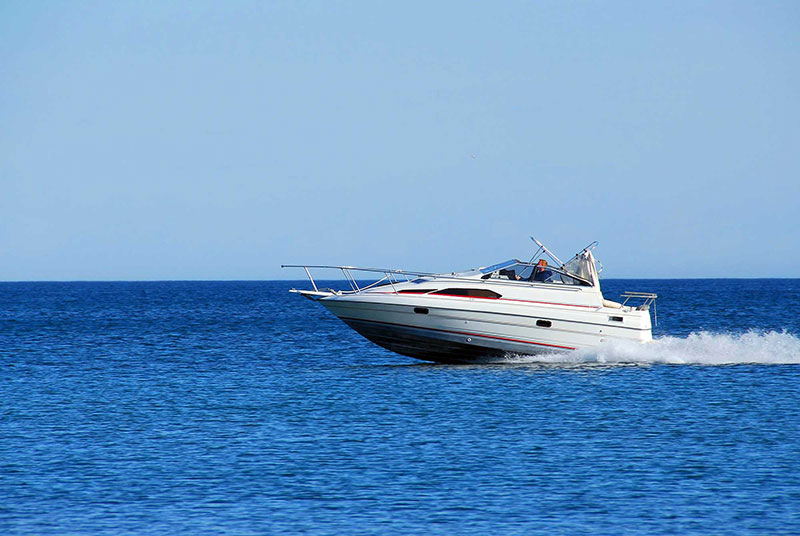
So, Boat vs. Ship Vs. Yacht?
Ultimately it comes down to this: all three of them are boats, but yachts are fancier, larger, and used for recreation, and ships are even larger, used commercially or by the navy, and are meant to cross oceans. The dividing line is sometimes thin, but generally speaking, when it comes to boats vs. ships.vs. yachts you can go by the adage “ I know it when I see it .”
Share article:
Have a question.
We have answers to your questions. So don’t hesitate to get in touch with our team today!
- GET MORE INFO
Feel free to ask us anything. All hands on deck. Let's sail
Thank you for sending us an inquiry, thank you so much for your enquiry.
Ship vs Boat vs Yacht: What's the Difference?
Navigating the vast waters of the maritime world can be both exciting and confusing. With so many different types of watercraft, it’s easy to get lost in a sea of terminology. Boats, ships, and yachts are often used interchangeably, but they have distinct characteristics that set them apart. In this article, we will set sail on a journey to understand the differences between boats, ships, and yachts. So, grab your life jacket and join us as we embark on this maritime adventure!
What is a Boat?
In simple terms, a boat is a watercraft that is smaller in size and typically used for recreational or personal purposes. Boats come in a variety of sizes, from small dinghies and rowing boats to motorboats and sailboats. They are designed for various activities such as fishing, water sports, cruising, and transportation on inland waterways. Generally, boats are powered by engines, sails, or oars, and they are ideal for navigating rivers, lakes, and coastal areas.
Boats are known for their versatility and can be found in different forms, including fishing boats, speedboats, pontoon boats, and cabin cruisers. Their compact size and manoeuvrability make them perfect for personal enjoyment and exploring smaller bodies of water.
What is a Ship?
Moving up in size, we encounter the concept of a ship. Ships are larger watercraft designed for commercial, military, or large-scale transportation purposes. Unlike boats, ships have specific characteristics that set them apart. Size is one of the defining factors, with ships being significantly larger than most boats. Ships are capable of travelling long distances across oceans and are equipped with the necessary facilities to accommodate crew members for extended periods.
Ships come in various forms, including cargo ships, oil tankers, container ships, and cruise liners. Their purpose is to transport goods, passengers, or resources on a larger scale. Ships are built to withstand rough seas and adverse weather conditions, and they often possess advanced navigational and safety systems.
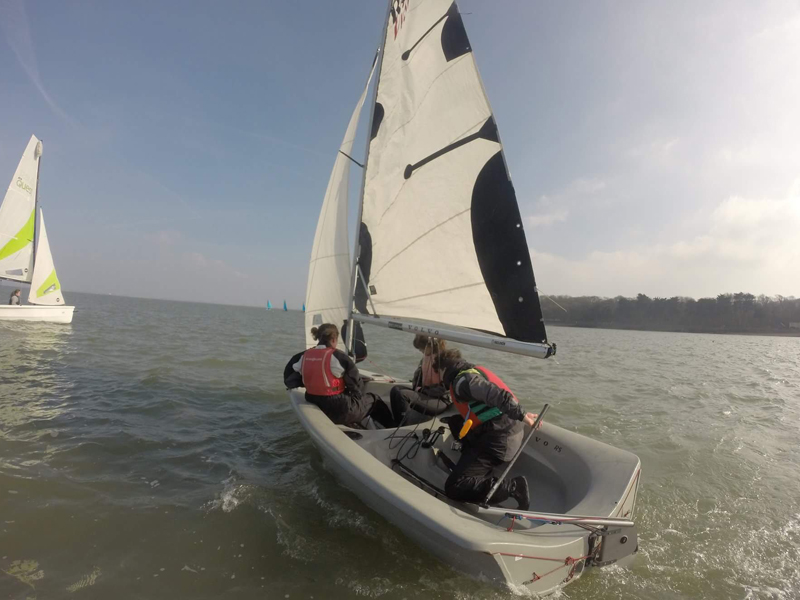
What is a Yacht?
Now, let’s set our course towards the world of luxury and leisure as we explore yachts. Yachts are watercraft that are primarily associated with private recreational use and luxury. While yachts can vary in size, they are generally larger and more luxurious than most boats. Yachts are designed to provide comfort, style, and an indulgent experience for their owners and guests.
Yachts are often equipped with luxurious amenities such as spacious cabins, lounges, dining areas, swimming pools, and even helipads. They are often a symbol of wealth and leisure, offering a wide range of recreational activities onboard. Yachts are commonly used for cruising, island hopping, and entertaining guests in style. Yachts are often crewed by professionals who ensure that the yacht and its guests receive top-notch service and attention to detail. Another key area of yachting is yacht racing which is a popular sport worldwide, for both regattas and offshore ocean racing. Yacht racing has a big following of competitors and spectators.
Find out our current yacht careers available .
What is a Superyacht?
Within the world of yachts, there exists an elite category known as superyachts. Superyachts are the epitome of luxury and extravagance. These exceptional watercraft are typically over 24 meters (79 feet) in length and offer unparalleled features and amenities. Superyachts boast multiple decks, spacious cabins, lavish interiors, state-of-the-art entertainment systems, and even onboard spas.
What sets superyachts apart is their exclusivity and customisation. They are often built to the owner’s precise specifications and incorporate the latest in design, technology, and comfort. Superyachts are a testament to engineering marvels and are synonymous with opulence and grandeur.
Explore more tips about superyachts .
Ship vs Boat vs Yacht
In terms of size, boats are the smallest, followed by yachts, and then ships, which are the largest of the three. Boats are typically used for personal or recreational purposes, while ships are primarily employed for commercial or transportation activities. Yachts, on the other hand, cater to the luxurious and leisurely desires of their owners and guests.
Another key factor that distinguishes these watercraft is their functionality. Boats are versatile and can be used for a variety of activities, such as fishing, water sports, and cruising. Ships, with their larger size and cargo-carrying capabilities, are designed for transporting goods or passengers over long distances. Yachts, as we’ve discovered, focus on providing a lavish experience and are associated with leisure and luxury or with racing.
So while boats, ships, and yachts all belong to the maritime world, they have distinct characteristics and purposes.
Start Your Maritime Career at UKSA
If you’re inspired by the world of boats, ships, and yachts and have a passion for maritime pursuits, consider embarking on a career in the industry. UKSA offers a range of courses and career development programs that can help you set sail on your maritime journey. Whether you dream of becoming a sailor, marine engineer, or yacht captain, UKSA provides the training, guidance, and support to turn your aspirations into reality. Explore the possibilities and chart a course for an exciting and fulfilling maritime career with UKSA!
Contact our team now .
Latest posts

“Boat” vs. “Ship”: Chart A Course To Understand The Difference
- Boat Vs. Ship
- Yacht Vs. Boat
Ahoy, me hearties! A true seadog worth their salt would never let aboard a landlubber who calls their ship a boat . That kind of mixup is the talk that gets you walking the plank!
In this article, we’ll sail the seven seas of nautical knowledge to define the difference between the words ship and boat , explain what they refer to in technical and casual use, provide examples of different kinds of both ships and boats , and we’ll even clear up the meaning of the word yacht .
🚢 Quick summary
In casual use, the word boat is often used to refer to any watergoing vessel, regardless of its size or how it’s powered. However, large oceanfaring watercraft—those that use multiple sails or engines—are more properly called ships . In contrast, the word ship isn’t commonly applied to smaller craft. The word yacht is typically used to refer to any larger noncommercial vessel—one used for sailing or other recreation, as opposed to business.
What’s the difference between a boat and a ship ?
By definition, a boat is “a vessel for transport by water,” “a small ship,” or “a vessel of any size built for navigation of rivers or inland bodies of water.” In casual use, the word boat is used to refer to any vehicle used to travel on the water—anything from a canoe to an ocean liner.
In this kind of casual and general usage, the word boat is often used to refer to watercraft of all sizes and types, as you can see in the variety of terms that include the word, such as sailboat , motorboat , fishing boat , rowboat , tugboat , paddleboat , and lifeboat .
In contrast, the word ship is typically reserved to refer to a large, ocean-faring vessel propelled by multiple sails or engines.
(Of course, the word ship is also used to refer to large, nonwater craft, such as airship and spaceship .)
In technical, nautical contexts, the word ship sometimes specifically refers to a sailing vessel that has three or more square masts. As is the case with boat , though, the word ship is applied in the name of a variety of large watercrafts, including cruise ship , cargo ship , pirate ship , battleship , longship , and steamship .
Go Behind The Words!
- By clicking "Sign Up", you are accepting Dictionary.com Terms & Conditions and Privacy policies.
- Email This field is for validation purposes and should be left unchanged.
In contexts where it’s important to distinguish the difference, the distinction made between ship and boat is typically based on the size of the craft being discussed and if it is used only for ocean or sea travel. Additionally, the word boat can refer to vessels that don’t have any sails or engines, such as a kayak or a rowboat, whereas the word ship usually refers to vessels with many sails or large engines. Even in casual usage, it’s very uncommon for someone to call a small craft a ship , unless they’re doing so jokingly.
One distinction made in nautical contexts is that the word ship often refers to vessels too large to fit inside other vessels. By contrast, the word boat is often used to refer to smaller craft that can fit inside larger ones. For example, a massive cruise ship may have a large number of lifeboats inside it.
What are you sailing? An ocean or a sea ? Learn the difference here.
Yacht vs. boat
The word yacht typically refers to a vessel used for private, noncommercial reasons (those other than business), such as sailing or racing. As a general term, the word yacht can refer to any watercraft that isn’t intended to be used to make money, which includes anything from racing sailboats to billionaires’ floating ultra-luxury mansions.
The word yacht is not used to refer to small vessels, such as row boats or canoes. In casual usage, a yacht may be referred to with the more general terms boat or ship , but certainly not all ships and boats are yachts .
What's the difference between "uncharted" and "unchartered" territory?
Commonly Confused

Hobbies & Passions
Word Origins
Current Events
- Name This field is for validation purposes and should be left unchanged.
Boat vs. ship: What's the difference? The annoying mistake some cruisers keep making

Vacationing on a cruise ship? That's great, but for the love of all that is nautical, please don't call it a boat.
Modern-day cruise behemoths have earned the right to be called ships. The name is grand, it implies stature, and it lets everyone know that there's some sort of official larger purpose, whether it's the transportation of goods or of people.
What's the official difference between a boat and a ship? Technically, there isn't one that's universally accepted. Everyone seems to have their own ideas about what defines each, with no final verdict. Some say it has to do with size or tonnage, while others argue it's about how many masts the vessel has or whether it's a submarine (which, I'm told, is always a boat). Still others claim it's more about the bodies of water on which a vessel is designed to spend its days.
Regardless, the one certainty is that you'll sound like you have no idea what you're talking about if you refer to a cruise vessel — except maybe a riverboat — as a boat instead of a ship. In that vein, to help you understand the differences, let's take a look at some of the most popular differentiators, depending on whom you ask.
Vessel size
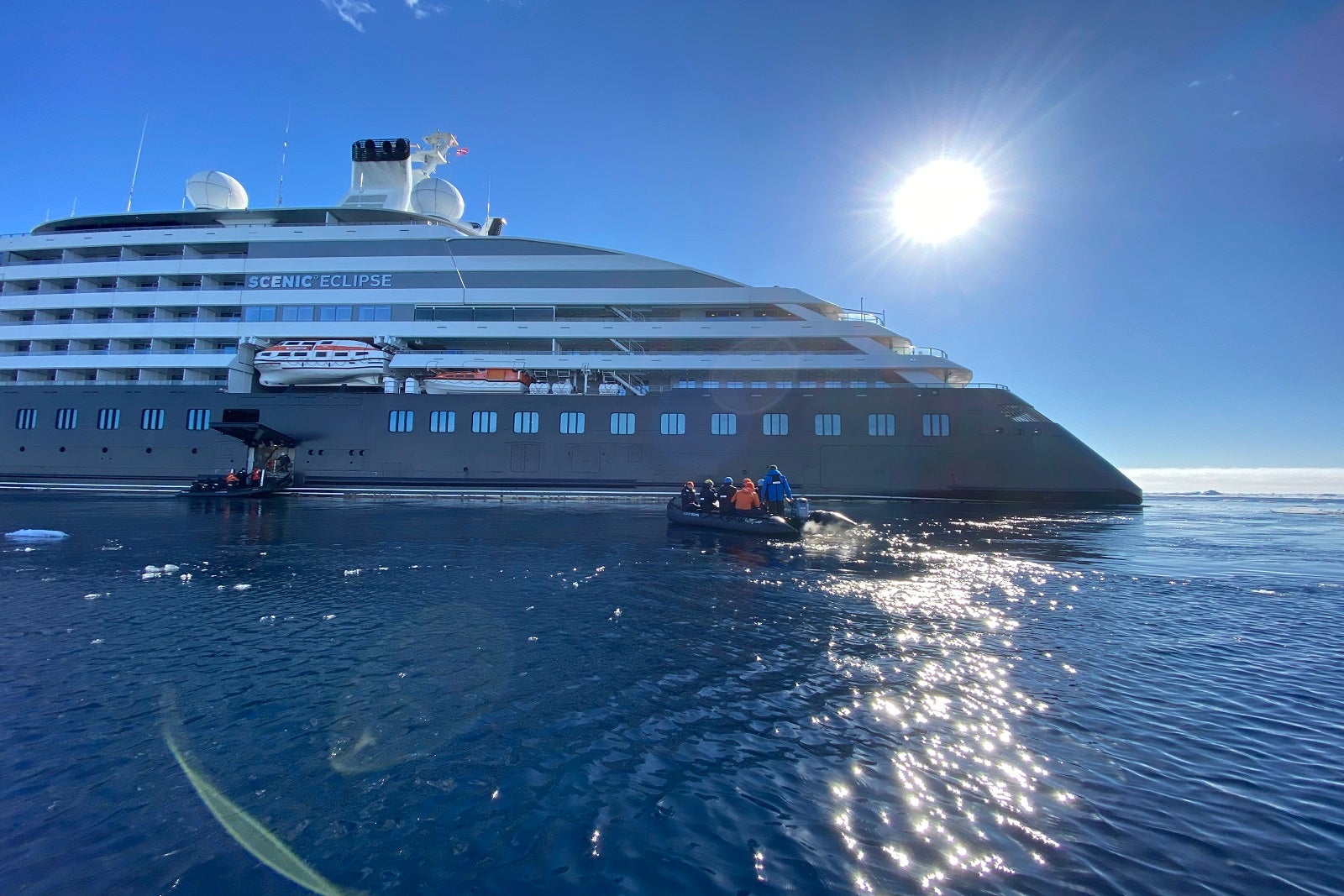
When you ask the average person what makes a vessel a ship versus a boat, they'll often tell you that it comes down to size. A ship is big; a boat is small. That seems to be the most common consensus, but those terms are arbitrary. What constitutes large and small?
In researching, I've discovered there's no official length at which a vessel becomes a ship. Sources cite everything from 100 feet to 200 feet in length and everything in between.
In terms of height, some seafarers insist that any vessel with more than one deck is a ship, and anything with only a single deck is a boat, as presented by The Guardian via a reader in the paper's Semantic Enigmas section.
Another common size-related refrain — one that's used by the United States Naval Institute — is that if a vessel is large enough to carry other vessels, it's a ship.
"In general, a boat is a watercraft ... that is small enough to be carried on board a larger one, and that larger one is a ship," said Lt. Cmdr. Thomas J. Cutler in a blog post on the USNI's website . "This is sometimes expressed this way: 'A ship can carry a boat, but a boat can never carry a ship.'"
Vessel tonnage
Tonnage is another determinant some entities use to qualify vessels as ships instead of boats. In fact, the maritime information website Marine Insight claims it's one of the most important factors to consider.
Vessels of more than 500 tons, regardless of size, are ships, according to the site.
Where the vessel sails

I recently sailed on my first U.S. river cruise, during which a lecturer explained that boats are specifically built for inland waterways, such as lakes and rivers. "This is a boat, despite its size," she said, also noting that it carries lifeboats (which would make it a ship by some definitions).
Supporting this theory is Scientific American , which quotes The Straight Dope (Cecil Adams, the self-proclaimed smartest man in the world) as saying, "With regard to motorized craft, a ship is a large vessel intended for oceangoing or at least deep-water transport, and a boat is anything else."
How the vessel corners
A handful of online query results say another way to tell a ship from a boat is by observing the direction in which it leans when it turns.
"A U.S. Navy rule of thumb is that ships lean towards the outside of a sharp turn, while boats lean towards the inside," The Maritime Post said. For a more relatable visual, think about a motorcycle versus a car. The former leans in as you go around a turn; the latter leans away from the center of the turn.
Vessel propulsion and design
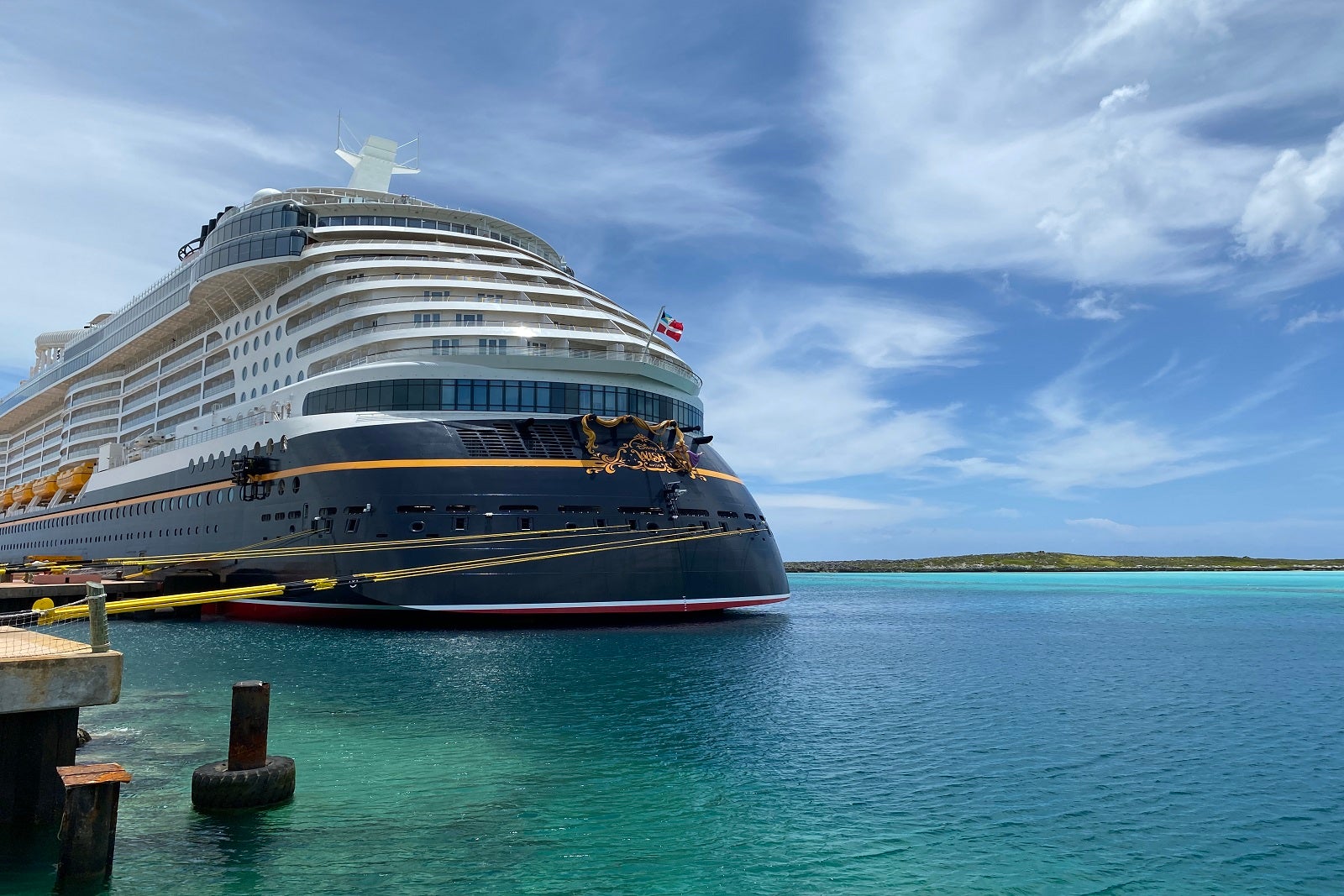
As you might expect from a larger vessel, ships often have more complex construction than boats. They also have more machinery on board than boats do, whether that's in the way of navigation or engine room accouterments.
Further, how they're propelled might differ. Most modern-day ships are powered by engines, whereas boats can be moved by anything from oars or sails to engines, according to Marine Insight .
Number of masts on the vessel
In terms of sailing vessels, if a rig has three masts or more, it's considered a ship, per the New Bedford Whaling Museum in Massachusetts. To qualify, it must also have square sails on all masts.
Obviously, most modern-day cruise ships don't have masts. (Exceptions are ships from Windstar and Star Clippers.) Although this rule is less relevant today, it does come up frequently in maritime circles when discussing the difference between a ship and a boat.
Bottom line
There's no hard-and-fast rule when it comes to determining whether a vessel is a ship or a boat. Generally, the most common ideas about this seem to revolve around size: tonnage, number of decks or whether or not the vessel can carry other boats.
Lots of people will have opinions about the "correct" criteria, but the bottom line is that you should never refer to a cruise ship as a boat if it carries travelers on the ocean for vacation.
Got more cruise questions? TPG has answers:
- Man overboard: Why do people fall off cruise ships?
- What is baked Alaska, and why is it paraded around cruise ships?
- What are the largest cruise ships in the world?
- What is a lido deck on a cruise ship?
- What is tendering on a cruise ship?
- What's the difference between a cruise concierge and a butler?
- What is a gentleman host on a cruise?
- What is the Jones Act and how does it affect cruise ships?
- What's a cruise cabin guarantee and will it save you money?
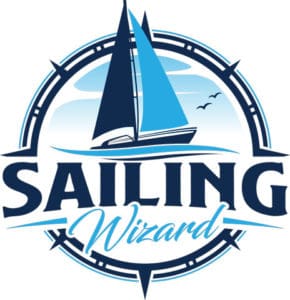
What’s the Difference Between a Boat, Yacht & Ship?
Whether you are a brand new sailor or just wanting to brush up on some terms, it is essential to know what to call a particular watercraft if you’re going to fit in while you’re at the docks or out on the water. There are many nuances and subtle differences between water vessel types, but below are some of the main differences.
In general, yachts are either sailing or motor vessels used for pleasure. Yachts are often luxurious and equipped with an overnight cabin. Boats can be either propelled sail or a motor and come in varying sizes. On the other hand, ships are usually motor-powered and much larger than boats.
Some of the differences between watercraft types can be a little fuzzy, but once you grasp the main differences between them, it becomes relatively easy to tell them apart. If you have no previous knowledge of watercraft, you are likely very confused about what defines a yacht, boat, and ship, so I’ll try to clarify any confusion you might have in the next few sections.
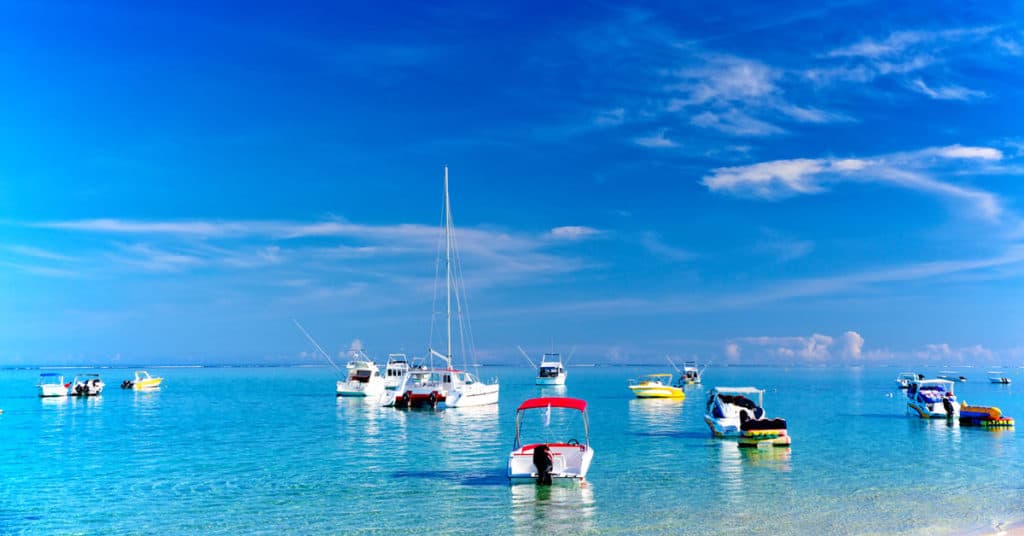
Similarities and Differences Between Boats, Yachts, and Ships
The many bodies of water all over the world are home to an extensive collection of different watercraft. There are so many shapes and sizes that they come in that it is nearly impossible to fit every single one into a specific classification.
However, in the following table, I did my best to loosely define ships, yachts, and boats so that it is easy to see the differences between the types of watercraft.
| Less than 197ft (60m) (usually ~25ft) | $15000 – $100,000+ | Pleasure, Residential, or Commercial | Motor, Wind, or Man Powered | |
| Greater than 33ft | $250,000 – $50,000,000+ | Pleasure | Motor or Wind Powered | |
| Greater than 197ft | $10,000,000 – $500,000,000+ | Pleasure, Residential, or Commercial | Motor Powered (Ancient Ships Used Wind or Man Power) |
As I mentioned earlier, it is impossible to fit EVERY SINGLE water vessel into a particular category, so there are tons of exceptions out there. In addition to the exceptions, different organizations, laws, and people classify types of boats slightly differently.
There is no universally accepted definition for ships, boats, and yachts, but instead many different sets of rules and regulations. In this article, I have tried my best to use the most commonly accepted definitions for each watercraft type.
Now that we’ve gone over some of the main differences and similarities between boats, ships, and yachts, let’s take a look at each type of vessel individually and look at their most prominent characteristics and attributes.
What Exactly is a Boat?
Boats come in a vast array of sizes and shapes. To many people, the term “boat” simply refers to nearly any watercraft, but there are actually a few restrictions and defining characteristics that all boats have. So let’s just get right into it and take a quick look at what exactly qualifies a vessel as a boat.
Overall Size of Boats
As I said before, there is a massive catalog of different types of boats, and they come in a variety of sizes. There are huge boats that hold lots of cargo or people, and then there are smaller ones that barely can stay afloat with a single person on board.
Typically, boats are defined as watercraft that are less than 197 feet long. However, most boats you are likely to encounter on the water are usually around 30 feet long.
General Price Range of Boats
Again, it is hard to accurately give a price range for all boats because they come in so many different sizes, styles, and types, but most modern boats seem to fall in the $1,500 to $100,000 range.
Small Jon boats can cost even less than $1,500, while large sailboats and houseboats can cost well above $100,000.
Most Common Uses of Boats
Boats are used all over the world for a variety of different reasons and to do many tasks. Many types of boats serve a wide range of uses, but most are primarily used as a residence, for pleasure, or commercially.
Some of the most popular types of boats, such as sailboats, bowriders, and dinghies, are commonly used for enjoyment, fishing, racing, or other pleasurable activities. There are also many types of houseboats used as residences and commercial boats used for chartering or moving goods or people.
Propulsion Method of Boats
Due to the wide variety of boats, you are likely to find boats propelled by almost every propulsion method imaginable. Some of the more popular propulsion methods for boats to use are man-power, wind power, and motor power.
Boats on the smaller end often use the power of the people on board to row or paddle, while larger boats rely on sails or powerful motors attached to the stern. Many boats use more than one propulsion method, either together or with one of them as a backup.
What Exactly is a Yacht?
Yachts have many of the same attributes as boats, but their quality, size, and luxury really set them apart. When someone says “yacht,” many people imagine watercraft that are SUPER LARGE, and while there are lots of massive yachts, many smaller boats also qualify as yachts, which might surprise you.
Overall Size of Yachts
There are many different sized yachts, and the rules regarding how big they have to be are not very strict. In general, luxury watercraft greater than 33 feet in length are considered yachts. However, boats smaller than 33 feet are sometimes called yachts if they are exceptionally luxurious and elegant.
There is no upper limit to how large a yacht can be. Yachts longer than 100 feet are often referred to as mega yachts, and ones over 150 feet long called are super yachts.
General Price Range of Yachts
Because the very definition of a yacht requires it to be very luxurious, they often come with quite a price tag as a result. There is quite a range of different price points for yachts, ranging from $250,000 to $50,000,000 and beyond.
Most Common Uses of Yachts
Yachts, because they are so expensive to maintain and purchase, are primarily used for pleasure purposes. Day trips out on the water are typical for yachts, although they often have overnight cabins, so longer excursions are popular.
Chartered yachts are also very popular, which bridges the gap between commercial and pleasure. Although, when you are on a chartered yacht, it is usually for the sole purpose of having a great time and enjoying yourself.
Propulsion Method of Yachts
Because yachts are considered very luxurious and often so large, they are usually solely propelling using motor power. Even if a yacht is on the smaller end of the spectrum, they often only use a motor as a means of driving the craft through the water.
However, many large sailing yachts out there use sails and the wind to propel the vessel. So while the large majority of yachts use motors, keep in mind that some large and luxurious sailboats can be considered yachts.
What Exactly is a Ship?
Throughout history, large ships have been a helpful tool for many civilizations and have allowed them to transport goods and explore places beyond their homes. In modern times, ships are quite common and are used for a variety of different reasons.
Overall Size of Ships
One of the primary characteristics of ships that set them apart from boats is their size. Ships, especially in modern times, are often MASSIVE and are restricted to navigating only extensive waterways.
Vessels greater than or equal to 197 feet long are often considered ships. However, most ships today are huge and often fall in the 1,000-foot range or larger.
General Price Range of Ships
Most individuals will never own a ship due to their extreme maintenance and the cost of purchasing one. While many smaller ships are far less expensive, most modern ships cost anywhere between $50 and $500 million.
Large and luxurious cruise ships can even cost upwards of $1 billion to construct, and that’s not even taking into account staff, maintenance, and other costs.
Most Common Uses of Ships
Ships perform many different duties throughout the world, but usually, they are used to transport passengers or goods over long distances. In addition, they are also often used by military, scientists, fishers, and a plethora of other professions and people. They are also often used for pleasure purposes, in the form of passenger cruise ships.
Overall, ships encompass a large selection of vessels that perform many different duties.
Propulsion Method of Ships
Due to their large size, most modern ships are propelled using motors. However, even though ships are equipped with massive motors, they are still pretty slow and often move at around 20 knots per hour, although some move much quicker.
While most, if not all, ships today use motors to propel themselves through the water, this was not always the case. Before motors were around, many civilizations used ships for military, exploration, transportation, shipping, and many other uses. During these times, ships were powered primarily by man and wind power. Even today, you can occasionally find a sail-powered ship, though they are quite rare.
James Gerard
Hi, I'm James! I started sailing at a very early age here in the UK, and have enjoyed so many opportunities to sail all over the world. I created this website to share the many sailing tips I've leaned over the years, so that you can also discover the joy of sailing with safety and confidence.
Recent Posts
How to Predict Wind Direction & Speed from a Surface Pressure Chart
Learning how to read a surface pressure chart will allow you to predict the wind speed and direction based on the weather chart. This will help you in planning your next sailing trip.
What Does a Black & Yellow Buoy Mean? (Cardinal Marks Explained)
If you see a black and yellow buoy while you're sailing, don't ignore it. Cardinal Marks are there to help you avoid hidden hazards in the water. This helpful article will help you to identify a...
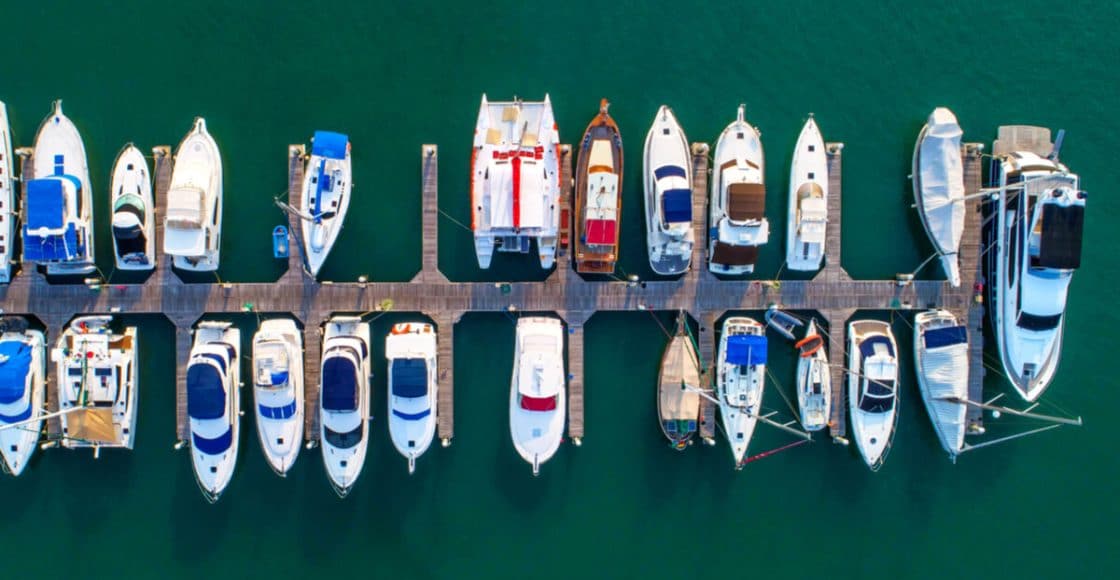
Yachts vs. Boats: What are the Differences?

Table of Contents
Last Updated on April 13, 2022 by Boatsetter Team
Many people use the words “boat” and “yacht” interchangeably, and some lean on the latter to make their ride sound more impressive. But what are the key differences between boats and yachts?
First, let’s look at some broad definitions of a boat, a yacht, and other related vessels.
- “Boat” can refer to just about any kind of vessel— towboat , fishing boat , center console , houseboat , and so on.
- “Dinghy” designates a small boat with a human or wind means of propulsion including a rowing dinghy or sailing dinghy. It also refers to a tender to a bigger boat or yacht.
- “Ship” is a large commercial boat, often used for distance travel and transport of goods or passengers – cruise ship, container ship, etc.
- “Yacht” is typically a larger boat with luxury amenities used as a recreational vessel— motor yacht , sailing yacht .
- “Superyacht” is a large yacht and is often also called a mega yacht . The delineation used to be at 80-feet but again, with today’s size creep, anything under 100 feet would just simply be called a yacht.
So, yacht or boat? Let’s dive deeper into the elements that differentiate a boat from a yacht.
Own a Boat or a Yacht? Learn How to Offset the Cost of Ownership by Listing on Boatsetter
Size of the Vessel
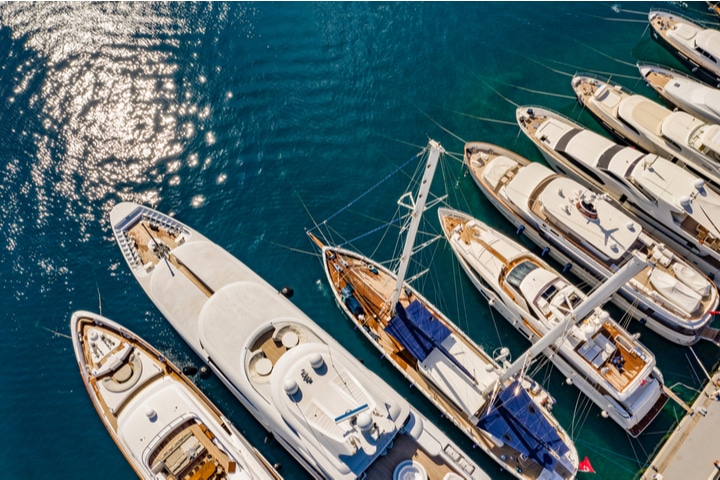
Some place a hard line at 35 feet. Below that, you have a boat and above, it’s a yacht. However, that’s an artificial differentiator.
Just 30 years ago, a 30-foot boat was considered large and could have been a yacht but as recreational boats grow longer, the term yacht has been pushed up the scale.
That said, a well-kept 40-foot boat designed for recreation can technically still be called a yacht (although larger vessels are likely to cost more, price isn’t a good indicator of yacht status primarily because it fluctuates with brand, age, and amenities).
Check out local yacht rentals near you to understand how size plays a difference.
What it’s Used For
A yacht is a vessel designed for recreational purposes. It generally operates on open waters (rather than small lakes or rivers) and has accommodations for overnight guests.
A cruise ship, on the other hand, accommodates a large number of passengers in a commercial setting whereas a yacht carries a smaller number (of paying or non-paying) passengers for private recreation.
Onboard Technology
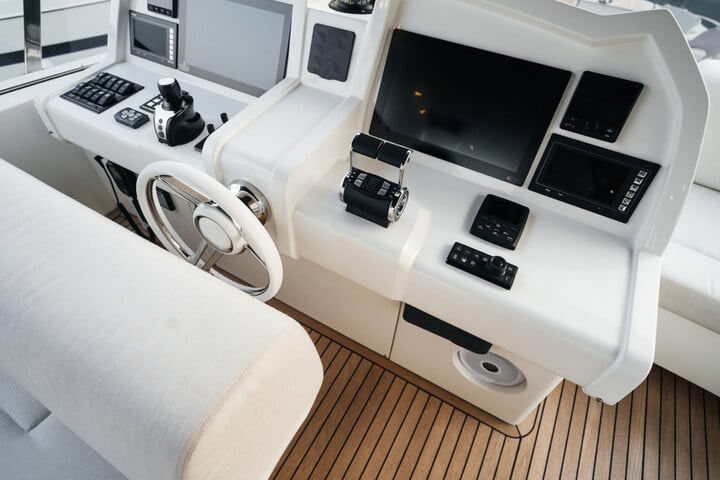
Advanced technology for navigation, communications, and system operation as well as redundant systems for safety can be found on a yacht that is likely to venture farther.
Again, there are caveats because today’s towboats that are fun day boats also feature technology such as GPS and digital switching that integrates many electrical and electronic features.
Propulsion Types
This is a tricky one. “Yacht” comes from the Dutch word “jaght” which referred to a sailing vessel that was used by the navy to capture pirate ships and later for recreation by the affluent.
Today, a yacht can be a large sailing vessel or a motor yacht. All larger yachts will have a motor for propulsion whether they have sails or not. Sailboats by design have smaller motors so trying to put a horsepower minimum on yacht propulsion is simply inaccurate.
Some define a yacht as having multiple crews to operate the vessel and tend to passengers or guests. The larger the yacht, the more crew will be required to navigate, maintain and service the vessel. That said, a couple who owns a 50-footer can call their boat a yacht although it’s owner-operated.
Luxury and Amenities
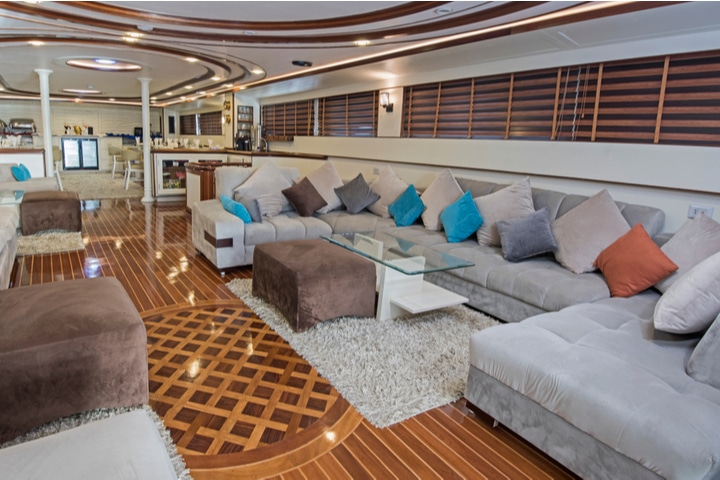
This is perhaps the best measure of a yacht. If the vessel offers accommodations, a galley , a head , and is luxurious in its presentation, it’s most likely a yacht.
That said, there are lots of center console fishing boats and towboats that are pretty nicely equipped these days and they wouldn’t be called a yacht.
All yachts are boats, but not all boats are yachts—and the lines are blurry. The word yacht elicits images of posh seafaring experiences while a boat evokes ideas of fun and perhaps work. Do some research to learn what size and type of boat or yacht is best for you .
To a degree, the point at which a boat becomes a yacht is in the ear of the beholder but if you focus on size, amenities, and the type of use, you’ll be able to discern the difference. Then all that remains is to find a way to spend time and have fun on any kind of vessel.
Browse All Available Boat & Yacht Rentals Across the Globe

Zuzana Prochazka is an award-winning freelance journalist and photographer with regular contributions to more than a dozen sailing and powerboating magazines and online publications including Southern Boating, SEA, Latitudes & Attitudes and SAIL. She is SAIL magazines Charter Editor and the Executive Director of Boating Writers International. Zuzana serves as judge for SAIL’s Best Boats awards and for Europe’s Best of Boats in Berlin.
A USCG 100 Ton Master, Zuzana founded and manages a flotilla charter organization called Zescapes that takes guests adventure sailing at destinations worldwide.
Zuzana has lived in Europe, Africa and the United States and has traveled extensively in South America, the islands of the South Pacific and Mexico.
Browse by experience

Explore articles
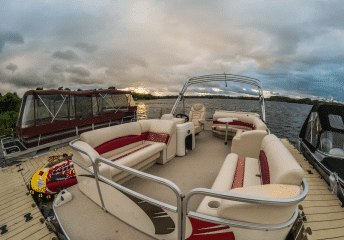
Pontoon Boat Accessories: A Complete Guide
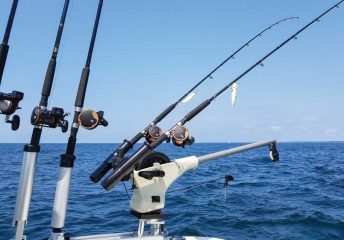
Lake Michigan Fishing Guide

Buying a Fishing Boat: 6 Things to Consider
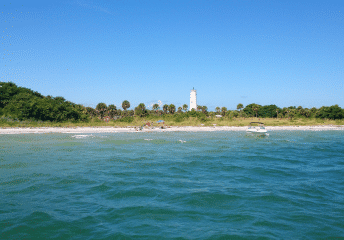
Egmont Key: Boating & Snorkeling Guide
- Pontoon Boats
- Personal Watercraft
- nauticalknowhow
- Nautical Knots
- Tools and Calculators
Boat vs Ship: What’s the Difference?
The internet is full of dictionaries with different definitions of what is and is not a boat. You may be surprised (or maybe not) to see that some describe a ship as a boat and a boat as a ship. Here are two ways to define both boat and ship.
Boat Definitions
- a vessel for transport by water
- a small ship
Ship Definitions
- a vessel, especially a large oceangoing one
- a boat, especially one propelled by power or sail
While some definitions rely on using one term to define the other, some of them also include a reference to size, which is at least mildly helpful and is at the core of the difference between a ship and a boat.
Large Vessel vs Small Vessel
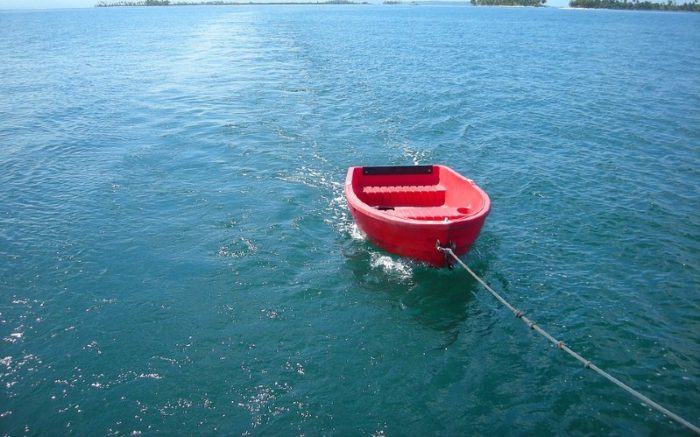
Generally speaking a ship is a large vessel and a boat is a smaller one. Of course, size is pretty relative. If an 18 foot vessel is a boat is a 200 foot vessel a ship? What about a 500 foot one? Where’s the line between ship and boat?
There’s a popular saying that goes “a ship can carry a boat but a boat can’t carry a ship.” Another popular one is that a ship leans left when it turns right. A boat leans right when it turns right.
According to some definitions a ship is a vessel weighing at least 500 tons. A boat would therefore be anything that is smaller in size, which encompasses most leisure craft and the sorts of vessels any of us are likely to be using at sea.
Operating Ships vs Boats
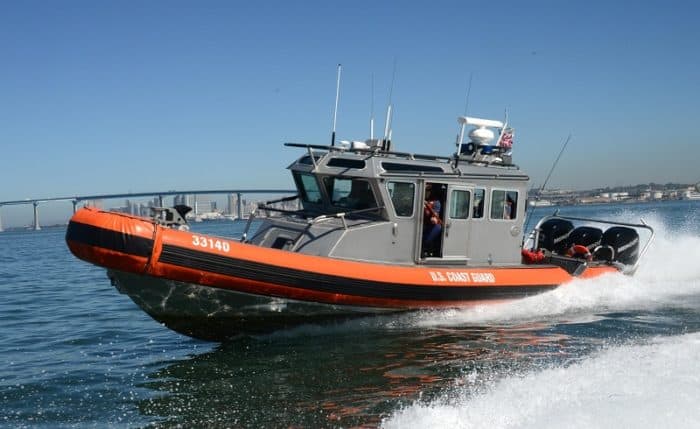
Ship Operations
Ships have a lot of serious and heavy engineering going on. They need to be operated by qualified technicians, not to mention all the additional systems from communications to navigation that are all highly specialized as well and not something an average boater will have the knowledge to operate.
Larger vessels like ships all operate using extreme amounts of power to offset the incredible size of weight. A Nimitz class aircraft carrier has a small nuclear reactor to keep it in motion. The Wonder of the Seas has six marine-diesel sets of engines. Each set is made up of three 16 cylinder engines and three 12 cylinder engines. The 16 cylinder engines can each burn through over 1,300 gallons of diesel fuel per hour. Compare that with what the outboard motor on something like a bass boat may be burning through. The fuel used to start the cruise ship the Wonder of the Seas could very well be more than your boat will ever use.
Sailing ships do exist though they are less popular these days. In the time before commercial vessels with big engines out in the deep water these would have three or more masts, and travel the oceans on sails rather than engine power.
Boat Operations
Boats have a variety of ways that they can be operated. You paddle a small boat like a canoe around, after all. If you have a catamaran you can hoist a sail and use wind power or you can use a motor to propel it. Even those boats that do operate under power have some variety as well. Outboard, sterndrive and inboard engines are all possibilities. There are also jet boats that use jet propulsion rather than motors with propellers for many smaller vessels.
Ship vs Boat Capacity
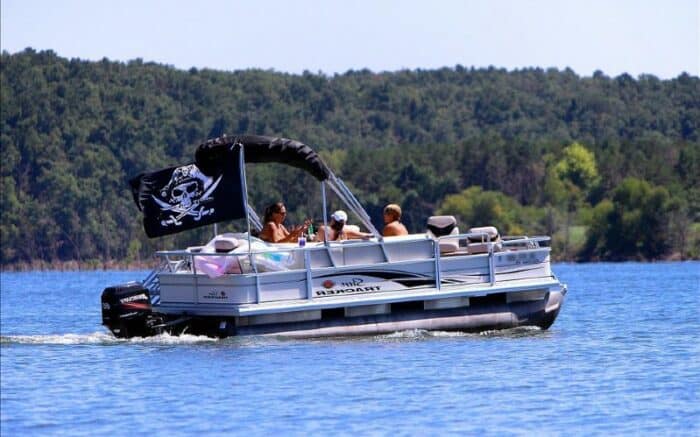
The size of a ship versus the size of a boat is key to understanding how they are used.
Ship Capacity
The largest shipping container ship in the world is over 1,300 feet long and weighs 240,000 tons. In 2021, a ship of similar size broke a world record when it carried 21,710 20-foot long shipping containers carried aboard in a single journey.
Ships carry a lot. That can be cargo as in the case of that massive shipping container ship or even crew and passengers. The US Navy Nimitz class aircraft carriers are capable of carrying a permanent crew of 5,680 people at one time. That said, Royal Caribbean has a cruise ship called the Wonder of the Seas that can handle 6,988 passengers when maxed out plus 2,300 crew for a total of 9,288 people on board.
Clearly, a ship is a vessel built to handle large numbers of people with a large cargo capacity.
Boat Capacity
The largest yachts may be able to accommodate a large number of people. Some mega yachts are so big they even have room for smaller boats to dock inside of them. These are, obviously, very rare. Most boats are not designed for cargo or massive crew transport. Instead, their purposes range from cruising to fishing to search and rescue. The cargo and crew capacity is considerably smaller than a ship.
Ship vs Boat Design and Layout
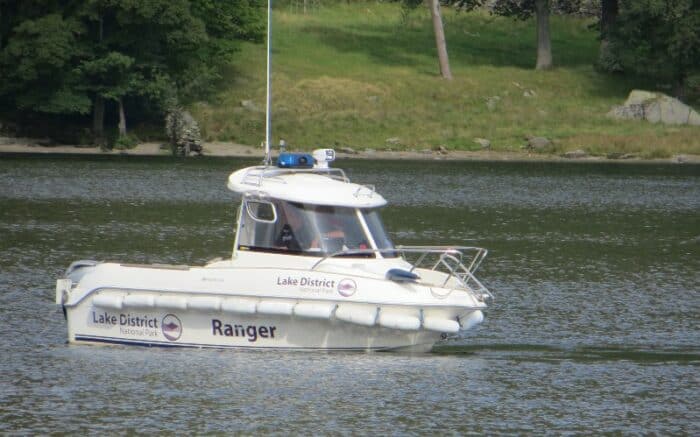
Boat Design and Layout
A canoe can literally be a hollowed out log, so there’s something to be said for the simplicity of a boat. As they get more complicated they can have cabins and berths, pilothouses, fly bridges, and more. But even the most luxurious of houseboat or yacht will still be fairly simple overall. Living quarters, operational areas, an engine room, a deck. That’s about it.
Ship Design and Layout
The Wonder of the Seas has an actual park with 10,000 real plants growing in it. There’s a ten storey zipline on that ship somewhere, not to mention an ice rink. And that’s just the leisure areas. If we go back to the Nimitz class ships, remember, these have nuclear-powered engines in massive engine rooms. There are aircraft hangars below decks to hold the planes.
Ships are vastly more complex and their layout can often be similar to a city built in three dimensions. Put another way, it’d be all but impossible to get lost on a boat. The same can’t be said for some of these massive ships.
Owning Ships vs Boats
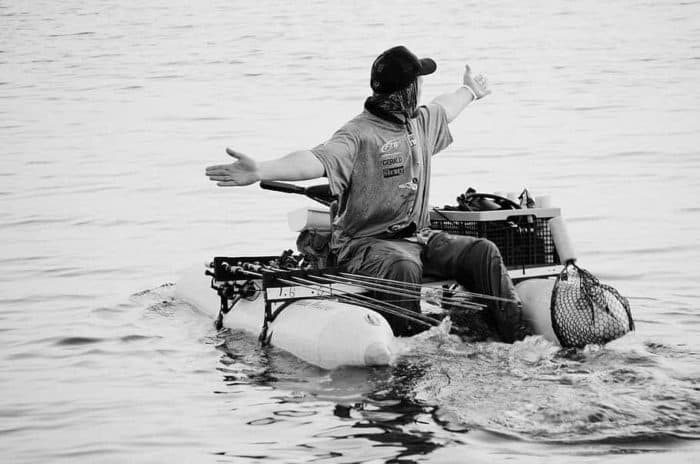
Owning a Ship
There’s technically no rule saying you can’t own a ship, or at last certain kinds of ships. But let’s be honest, most people do not and will not ever own ships. The largest ships cost hundreds of millions of dollars. Ships are, by and large, used by organizations which may be military, governmental, or commercial.
Owning a Boat
Boats are designed for small scale use and are typically owned and operated by individuals and smaller businesses. Most reasonable-sized boats may cost am owner a price within range of a car or, on the most luxurious end, a house.
Types of Ships vs Types of Boats

Common Ship Types
These vessels are most often seen in the open waters of the ocean.
- Naval ships
- Cruise ships
- Shipping containers
- Oil exploration or drilling ships
- Construction vessels
- Offshore barges
- Jack Up and Crane Ships
- Roll on/Roll Off ships
Common Boat Types
In contrast to ships, boats chiefly include many of the vessels you’ve likely seen in lakes, rivers and coastal areas including:
- Fishing boats
- Pontoon boats
- Patrol craft
One point of distinction when it comes to the difference between a ship and a boat rests on submarines. Any vessels like a submarine that operate underwater are generally considered boats.
Is a Cruise Ship a Boat? Areas of Operation
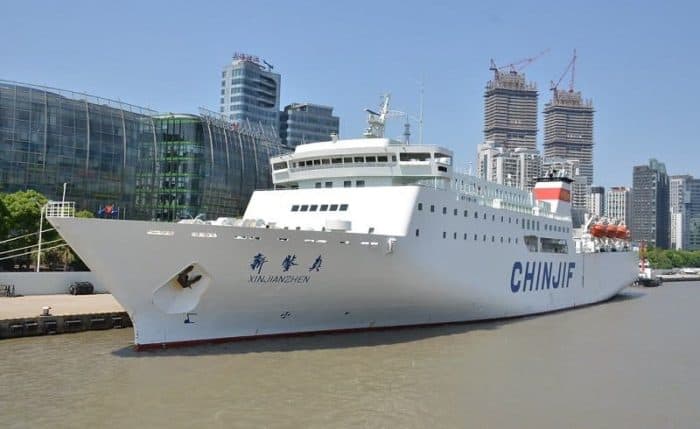
Ships travel the high seas. A cruise ship isn’t going into coastal waters along a beach unless it’s docking or you’re about to see how a ship sinks. Royal navy vessels don’t usually show up in the Thames over in England, for instance. Likewise, your jon boat should never be in an international shipping lane.
In other words, boats typically operate in restricted areas near coasts and along inland waters like the Great Lakes. Ships are out on the open ocean for long periods.
The Bottom Line
The key things to remember about a boat are that they are:
- Smaller than ships
- Able to hold far less crew and cargo
- Not as expensive as ships
- Often used for recreational purposes by individuals or smaller organizations
- Chiefly used on inland and coastal waters.
The key things to remember about ships are that they are:
- Much larger than boats
- Able to carry massive crew and cargo
- Extremely expensive
- Often used for commercial, government or military purposes
- Chiefly used in open waters
While both boats and ships are technically vessels that travel by water, the distinct differences make it clear that they’re pretty different. But whether you’re on a boat or a ship, make sure to stay safe and have fun.
My grandfather first took me fishing when I was too young to actually hold up a rod on my own. As an avid camper, hiker, and nature enthusiast I'm always looking for a new adventure.
Categories : Boats
Leave a Reply Cancel reply
Your email address will not be published. Required fields are marked *
Save my name, email, and website in this browser for the next time I comment.
More in Boats

What Is A Gunwale?

131 of the Best Hawaiian Boat Names

167 Patriotic Boat Names

The 138 Best Boat Names for Dog Lovers

The People’s Poncho Review and Ratings

Oru Lake Kayak Review

About Boatsafe
Established in 1998, BoatSafe is your independent guide into the world of boating, fishing, and watersports. We provide expert insights and detailed guides to help you find products tailored to your needs and budget.
Contact Boatsafe
- Address: 4021 West Walnut Street. Rogers, AR 72756
- Phone: (479)339-4795
- Email: [email protected]
Site Navigation
- How We Test
- Corrections Policy
- Privacy Policy
- Terms & Conditions
- Editorial Policy
- Affiliate Disclosure
Our Reviews

All content is © Copyright 2024. All rights reserved.
- The Inventory
- Beyond Cars

When Is a Ship a Yacht, and When Is It Not?
The difference between the two broad categories is determined by one key factor..
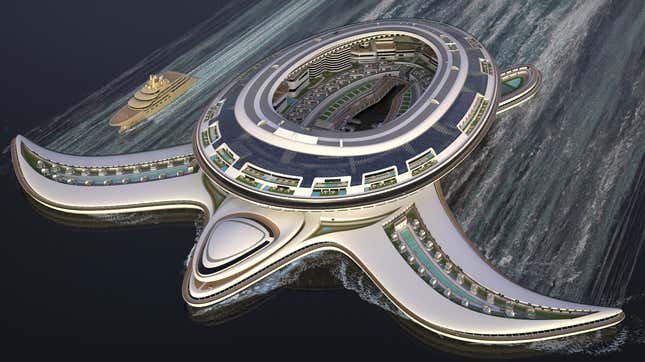
Yachts have been in the news a lot more frequently in recent years. There have been stories like when a Dutch yacht builder requested to temporarily dismantle an iconic bridge in Rotterdam to get a 417-foot-long sailing yacht commissioned by Jeff Bezos out to sea, or when authorities around the world seized the yachts of Russian oligarchs in the wake of Russia’s invasion of Ukraine. Usually, the most notable yachts have the prefixes super-, mega- and even giga- attached to convey their truly enormous sizes relative to most other privately-owned vessels.
Suggested Reading
As a result, ‘yacht’ as a term has basically become meaningless just by the sheer proliferation of private ships in recent years that defy all potential superlatives. It’s like when you say a word so often that it loses all its meaning. Why are there so many more huge luxury maritime vessels in the world? Rising levels of global wealth inequality? Technical innovation? I don’t know. The Pangeos is the latest planned monument to ostentatious wealth. The 1970-foot-long turtle-shaped ship is the brainchild of Italian designer Pierpaolo Lazzarini. However, this self-declared terayacht is not a yacht by definition.
Related Content
The only distinction between a yacht and a ship is simple: It is the vessel’s intended purpose. When you enter a foreign country, every customs agent will ask, “What is the purpose of your trip, business or pleasure?” It is the same when categorizing large water vehicles. The sole purpose of a yacht is recreation. If the craft has any other intended purpose, such as naval warfare or maritime commerce, it’s a ship. The U.S.S. Gerald R. Ford , a nuclear-powered U.S. Navy aircraft carrier, and the Carnival Celebration, a 5,280-passenger Carnival cruise ship , are both ships.
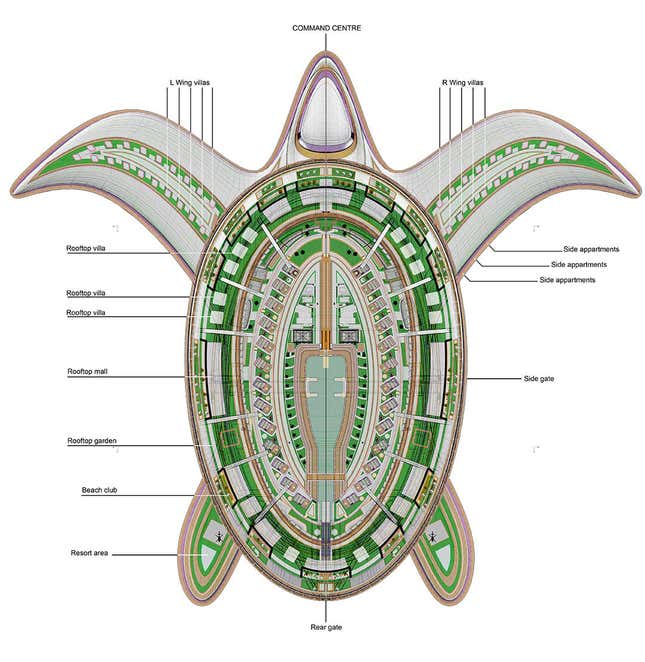
The plans for the Pangeos might feature private vacation villas and apartments. However, the absurd craft would also include also shopping malls and a hotel resort, making the Pangeos a ship. The Pangeos, named after the prehistoric supercontinent of Pangea, will likely never be built due to the ship’s $8 billion price tag.
Besides ship and yacht, boat is another commonly used term. The definition of a boat is much more vague and open to interpretation. Boats tend to be small personal craft and only carry a few people. Though, it’s common for sailors to refer to vessels of any size or purpose as a boat.


U.S Navy Commissions USS New Jersey, First Ever Submarine For A Mixed Gender Crew

World’s Largest Hotel-Branded Superyacht Sets Sail For Maiden Voyage

India Establishes Its First Maritime Arbitration Center

Yanmar Unveils Its First Electric Propulsion Product For Emission-Free Sailing

- 7 Differences Between a Ship and a Boat
Although most people know the difference between a ship and a boat, some can get confused between the two.
While talking about the difference between a ship and a boat, the first thing that comes to mind is their sizes. Usually, people consider ships to be massive whereas boats are smaller.
However, there are other aspects too, apart from size, which are discussed in this article.
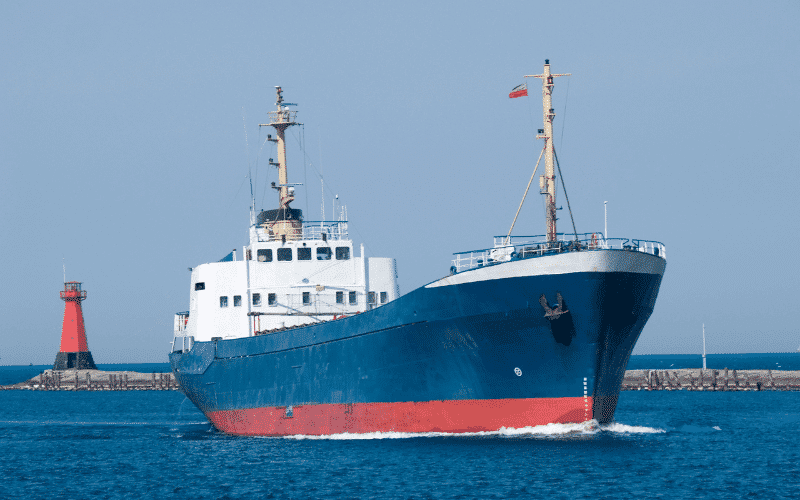
1. Size of Ship and Boat
The most important aspect while stating the difference between a ship and a boat is the size. It is said that the best way to differentiate between a ship and a boat is to remember that “A ship can carry a boat, but a boat cannot carry a ship.”
Technically speaking, a mode of water transport that weighs at least 500 tonnes or above is categorised as a ship. In comparison, boats are small in their structural size and displacement.
2. Operational Areas
Ships ply in deep waters, oceans and high seas. They are of various types like cruise vessels , naval ships, tankers , container ships , RoRo ships , and offshore vessels . They are mainly built for cargo/ passenger transportation across oceans.
Boats, in contrast, operate in restricted waters, near the coast and include ferrying and towing vessels, sail vessels, paddle vessels, kayaks , canoes , patrolling boats etc.
3 . Navigation and Technology
Boats are simple vessels with less complicated equipment, systems and operational maintenance requirements. Since ships are huge and carry large volumes of cargo over large distances, they feature advanced engineering, heavy machinery, and sophisticated navigational systems .
4. Crew Size
This is one of the major differences between a ship and a boat.
Ships have a large crew which consists of the Captain who commands the vessel, Second and Third Officers, Engineers, Cooks etc.
On the other hand, a smaller boat does not need many people.
5. Cargo Capacity
A boat is hardly used for carrying cargo. It is mostly used for recreational purposes like boating, fishing or ferrying people across short distances. Ships are built to be seaworthy since they carry thousands of tonnes across different ends of the planet.
Ships can also accommodate passengers or boats, whereas boat is a generic term used for a variety of watercraft.
6. Construction and Design
When it comes to construction and design, ships are complicated structures with various onboard machinery systems and equipment to ensure they are safe and stable to cross the rough seas.
A boat has a simple design and almost no machinery, though sophisticated ones have navigation systems, however they do not take up much space.
7. Propulsion
A boat can be powered by sails, motor, or human force, whereas a ship has dedicated engines. (Ships can also be propelled by sails or other advanced propulsion technologies)
Even though all vessels on the high seas are referred to as ships, submersible vessels are categorically termed as ‘boats.’
This is mainly because earlier, submersible vessels could be hoisted on ships till they were used in naval operations.
However, while talking about differences between a ship and a boat, only the vessels floating on the water surface are taken into consideration.

The use of the term ‘ship’ or ‘boat’ also depends on the region it is being used in. People often refer to a medium-sized fishing vessel as a boat, a medium-sized ferry or a recreational boat as a ship. As can be seen, people tend to generalise a vessel based on its size.
However, it is to be noted that the difference between a ship and a boat depends on many factors as discussed above.
You might also like to read:
- Types of Sailboats: A Comprehensive Classification
- A Guide to Different Types of Boats
- A Guide To Types of Ships
- Types of Fishing Vessels
Disclaimer : The information contained in this website is for general information purposes only. While we endeavour to keep the information up to date and correct, we make no representations or warranties of any kind, express or implied, about the completeness, accuracy, reliability, suitability or availability with respect to the website or the information, products, services, or related graphics contained on the website for any purpose. Any reliance you place on such information is therefore strictly at your own risk.
In no event will we be liable for any loss or damage including without limitation, indirect or consequential loss or damage, or any loss or damage whatsoever arising from loss of data or profits arising out of, or in connection with, the use of this website.

Do you have info to share with us ? Suggest a correction

About Author
Raunek Kantharia is a marine engineer turned maritime writer and entrepreneur. After a brief stint at the sea, he founded Marine Insight in 2010. Apart from managing Marine Insight, he also writes for a number of maritime magazines and websites.
Read More Articles By This Author >
Daily Maritime News, Straight To Your Inbox
Sign Up To Get Daily Newsletters
Join over 60k+ people who read our daily newsletters
By subscribing, you agree to our Privacy Policy and may receive occasional deal communications; you can unsubscribe anytime.

BE THE FIRST TO COMMENT
46 comments.
Please i am a National Diploma student of Maritime Academy of Nigeria Oron studying nautical science, i want to know more about the course
Hi.thank its so good and sufficient
As a profesional mariner of over 25 years I would like to “weigh in” on this subject. What I will say is not about the currently accepted distinction between ship and boats, but rather historical. When ships (powered by sails) began to start losing trade to vessels powered by engines (boats) they as an industry attempted to associate these vessels with unplesant attributes like noise, soot, vibration, and in some cases slower speed. The sailoing industry (both cargo and passanger) would say that you could SAIL on a quiet, clean, calm, fast ship or go one of those dirty loud vibrating slow BOATS with an engine. The concept a ship being superior and a boat being inferior was sucessfully instituted. The engine powered vessels simply side stepped the ridicule bestowed on the term “boat” and made bigger, faster, clean, quiet vessels and took the market from the sail powered vessels along with the defination of SHIP for themselves. i wont step into the curret debate of what constitutes a boat or a ship but the origins of the debate stem from new technology (steam engines) fighting over market share.
A large freighter (1000′ x 85′, think of the Edmund Fitzgerald) hauling iron ore on the great lakes is referred to by her crew and company as a boat, never as a ship!
“Boats in contrast, are operable in smaller/ restricted water areas and include ferrying and towing vessels, sail vessels, paddle vessels, kayaks, canoe, patrolling vessels etc. Boats are mainly used for smaller purposes and mainly ply in areas near to the coast.” “Technologically, boats are simple vessels with less complicated equipment, systems and operational maintenance requirements.”
Correct me if I am wrong but, isn’t a submarine classed as a boat? That kind of contradicts what you have stated above.
comment:the any where abroad/indian officers you can any time call me on 30 year’s on merchant officers
You can put a boat on a ship but not visa versa eg life boats…
What is the difference between a boat and a ship?
1. The boat leans to the right when turning right
2. The ship leans to the left when turning right.
This is what I have been told by a old (90 Year old boat capt)
Great reply’s. some years ago while on the QE 2 a passenger asked one of the officers when does this boat dock? The young officer replied. “Madam, this is a Ship not a boat, a boat is those you get into when this ship is sinking!
Hello. May I please ask for some assistance from the forum?
I am writing a blog/journal on the differences between ships and yachts. What has prompted this conversation is the plethora of ‘superyachts’ now plying the international oceans and performing well on deep water passages.
Surely some of these can come under the category of ‘ship’, and not yacht, since many are being built on a larger scale than anything we’ve seen in past years. My understanding of the determination of a ‘ship’ is : Length, Tonnage, Draft and Displacement.
I have read your forum discussion regarding use, but I am still unclear as to where the line is drawn for this category. Many of the ‘superyachts’ carry cars, helicopters, pools, and require very advanced equipment, captain and crew. Perhaps we will soon see this as a real conversation in the industry.
Appreciatively, Rosanne Allen-Hewlett For ‘The LUXE Report’ ( Sailor, racer of only boats and yachts )
I was told that the difference between a ship and a boat is that a ship has a funnel and a boat doesn’t, no matter it’s size….
David Musselwhwite’s comment is the best way to determine a boat of a ship. This holds true for submarines (boats). If it leans into the turn, it is a boat. If it leans out on a turn, it is a ship.
In response to comments about the Edmund Fitzgerald, when you spend your life on one you can call it whatever you want. I am sure they all knew it was a ship, I served 20 years in the Navy and always said I was heading back to the boat even though I knew it was a ship.
While in Boot camp in 1964, US Coast Guard, we were told that a ship is 95 feet or longer and a boat is 94 feet and under. That makes it pretty simple.
With over 30 years in the marine industry including working at sea, ship building and ship repair, I would offer my comments.
Yes all above is true. My understanding is that the bottom line is ” a Ship carries boats ie Lifeboats”. If it doesn’t have a proper lifeboat, it is not a ship.
The best a boat has is dinghies or liferafts etc. Consequently a submarine does NOT carry life boats. There are many broader requirements Size and the ability to navigate very heavy seas, such as those whipped up by a tropical Revolving storm (TRS). It must be designed to travel in the open sea in all weather conditions and have lifeboats that can do the same. They carry cargo or passengers and have a substantial crew to operate it including engineers.
As far as the Edmund Fitzgerald is concerned, these vessels are an enigma. They were large and qualify in most areas, but – was it capable of going to sea and did it have sea-going lifeboats? Ironically it suffered probably as bad a storm as it would have done at sea. The problem is that in fresh water the waters are more treacherous than salt water as they rise up far more quickly.
But then again it sank meaning that it couldn’t handle it. Yes it was a large vessel but was it a Ship – ?
What is difference among?
Marine Boat Marine Ship Marine Craft Ship Boat
What is difference between Marina and Marine?
Being the son of a WW II submariner. My dad cruised the Atlantic of the east coast of US and in many conversations about the war he always called his boat a boat never a ship.Thats it!!
The simplest and most accurate definition I stay with is that a ship can carry a boat but a boat cannot carry a ship . SIZE MATTERS !
Captain chalga: try to form a coherent sentence.
I asked a friend of mine, “What is the difference between a boat and a ship?” He said, “About 100 feet . . .”
Thank you for the information. My husband won this discussion. God Bless all who are bravely floating on/in one. I am terrified of the ocean or even a small lake. You have my utmost respect for your sacrifice. I love seafood but would never know the pleasure of eating it without you brave souls. Thank you.
As a proud Submariner I have to disagree and will always say that I serve on a boat.
There is the Boat of Millions of years,which is a very advanced spacecraft able to.travel the millions of light years betwen Galaxies.
And you have vessels such as the Motor Vessel Arlene out of Port Arthur.
I was once told that a ship had multiple decks and a boat had only one.
When I queried sailing yachts that had berths under part of the deck, it was modified to the deck on a yacht is as much structural as deck, but if a vessel has 2 or more non structural “floors” it is a ship.
Then I mentioned tug boats and fishing boats and it all got confused.
It’s a bit like the difference between horse and pony. Despite every one saying it’s size, the falabella is a horse and polo ponies are ponies.
A naval architect (constructors) view is that to be a ‘ship’ a vessel must have at least one continuous internal deck running the length of the vessel. Large Submarines may have complete decks forward however, going aft, it is normal to have to descend a ladder onto a lower ‘engine room’ deck-level or platform. Some large freighters have a similar construction with internal split deck levels and that is why they are correctly known as boats, although in some cases the term ‘ship’ feels more appropriate because of their large displacement. The argument regarding leaning into or out of a turn is an interesting idea, however this may have more to do with hull and propulsion characteristics than vessel construction. In reality, as with most nautical expressions, whatever feels best to use is probably best and relying on the opinion of a sailor, with regards to an explanation of nautical expressions, puts you at the mercy of a sharp sense of humour.
It might be worth mentioning that some might refer to a ship as “boat” as a diminutive term of endearment, similar to the personification of a car or a pet by assigning the human pronouns to them.
I was once told a SHIP sails the oceans, a BOAT sails on rivers and lakes.
IT SEEMS WE HAVE VERY KNOWLEDGEABLE SEA MEN IN THE HOUSE . BUT I AGREE TOTALLY WITH JEREMY MEYER
It’s always been my info is that a boat can be up to 197’ whereas a ship is over that length. As with anything, I’m sure there are exceptions.
some of the people got it spot on. Tilt away from direction of turn = ship. Tilt towards the direction of turn = boat.
There are two points on every vessel. Center of buoyancy and center of gravity. A ship’s center of gravity is above its center of buoyancy. A boat’s center of gravity is below its center of gravity.
Anyone can answer me why we only know the bareboat charter for any size of the ship? It never mentions bareship charter?
“some of the people got it spot on. Tilt away from direction of turn = ship. Tilt towards the direction of turn = boat. There are two points on every vessel. Center of buoyancy and center of gravity. A ship’s center of gravity is above its center of buoyancy. A boat’s center of gravity is below its center of gravity.”
Except a kayak (or canoe) is like a ship – cg is above cb. If you get a ruddered kayak up to speed and hit the rudder hard it will heel outward like a ship. Since the paddler can easily influence heel, if you want to make a hard turn you heel the ‘boat” outward (to lessen the ends in the water) and sweep stroke on the outward side to spin the “boat”. Is a kayak then a “ship”? Hardly. This is exactly the problem with trying to make one pithy statement to define a ship or boat. It is far more complex than that.
I completely agree with you that the difference between a ship and a boat is the size. One of my friends have a boat, she bought it from Boat Lagoon Yachting. Thanks for sharing!
If you can haul it on the back of truck (even trailered), it’s likely a boat…but if the anchor weighs in like a truck it’s definitely a ship. Obviously, some subs are one or the other regardless of whether you can stuff a (non-inflatable) life boat inside. [Army logic from qualified ex-boat commander, combat support boats, bridge section, Corps of Engineers.]
I grew up near the Welland Canal, and it’s true: vessels which plied the Great Lakes were called “lake boats”, or more commonly, “Lakers”. Oceangoing vessels a were always and reflexively called “ships”..
I am wondering if the naval architect”s comment about internal decks makes the difference, as even a non-engineer can see that a deck extending stem to stern would provide more stability to a vessel’s structure.
The lake boats are always longer than the ocean-going ships, so it’s not size.And we occasionally get a visit from “tall ships”, which are oceangoing sailing vessels, but relatively short.
That’s really informative post. I appreciate your skills, Thanks for sharing.
I will take a shot at this. The word marine is redundant before ship and boat. The word “marine” relates to the sea and one of the conditions of being a ship is that it is ocean going. This does leave the possibility of not being a river boat but a marine boat. I would use the expression sea-going boat.
Marine craft is a useful expression when there is a need to make it cleat that you are not referring an aircraft, space craft etc.
On a general note there are no absolute rules or definition. All we can do is give examples of how the words are used. Companies, governments, navies and anyone else are free to make gheir own definitions but nobody else is bound by them.
I served on the U.S.S. CG-19 ‘THE DZLE & U.S.S. CV-63 KITTY HAWK FOR THE US NAVY in the 80’s. So what about the placement of the helm being center of Bridge on a ship & on starboard side usually on a boat?
With many years of sailing lakes to blue water sailing and large power yachts I can offer this for abot of levity. Afterall,the SeaView had the ‘Flying Sub” flown or driven undersea,on the surface and flown by Captain,Admirals and sadly Polititians and insane quasi research criminals. The Flying Sub also had an inflatable Zodiac,so both could be considered Life saving vessels. Plus,it was really cool!
Can be as difficult as we want. My training was as a NCO (enlisted man in the USN. As others have stated, A ship will lean away from its turn. A boat will lean into the turn. This is naturally due to there the center line of gravity is located. Cargo ships mass above that line. A boat can be loaded onto a ship (lifeboats). Regarding Submarines, they are affectionately referee to , by the crew, as boats and that goes back to WWI /II, the ELB. Electric Boat Div of General Dynamics, located Groton Connecticut .
This design is wicked! You obviously know how to keep a reader entertained. Between your wit and your videos, I was almost moved to start my own blog (well, almost…HaHa!) Fantastic job. I really loved what you had to say, and more than that, how you presented it. Too cool!
More importantly… are they all “She’s” ?
I’ve been wondering about this since I was younger and saw The Hunt for Red October. The COB (Chief of the Boat) was an interesting character, and I wondered by a Sub Chief was called Chief of the Boat, if a sub was a naval ship. Some very interesting and fascinating answers in here! I like the one about how a ship turns, leaning into it or not. That makes sense to me. As for the tiny kayak/canoe exceptions to this, I’d guess that if a human weighs more than the ‘vessel’ and can manipulate it’s attributes of buoyancy or center of gravity whichever, with their own body, then it doesn’t really count as either a boat or a ship. It really has no deck, nor propulsion other than human muscle, no anchor, etc. I don’t see it as much more than a modern design for what used to be termed a ‘raft.’ But I am just spit-balling here, don’t blast me! lol
That’s really nice post. I appreciate your skills. Thanks for sharing.
All the information that you shared with us is very useful for us. Thank you for sharing with us.
Leave a Reply
Your email address will not be published. Required fields are marked *
Subscribe to Marine Insight Daily Newsletter
" * " indicates required fields
Marine Engineering
Marine Engine Air Compressor Marine Boiler Oily Water Separator Marine Electrical Ship Generator Ship Stabilizer
Nautical Science
Mooring Bridge Watchkeeping Ship Manoeuvring Nautical Charts Anchoring Nautical Equipment Shipboard Guidelines
Explore
Free Maritime eBooks Premium Maritime eBooks Marine Safety Financial Planning Marine Careers Maritime Law Ship Dry Dock
Shipping News Maritime Reports Videos Maritime Piracy Offshore Safety Of Life At Sea (SOLAS) MARPOL
WAIT! Did You Download 13 FREE Maritime eBooks?
Sign-up and download instantly!
We respect your privacy and take protecting it very seriously. No spam!
What is the Difference Between a Boat and a Yacht?
Key differences between ‘boats’ and ‘yachts’.
Boats and yachts are two different types of watercraft normally used for a range of recreational and commercial activities. Whilst people tend to use these terms interchangeably, there are numerous distinct differences between a boat and a yacht. There are six main differences that you should bare in mind when looking at boats or yachts , to help you gain the best understanding.

6 Differences Between Yachts and Boats
The first key difference between a boat and a yacht is their size. A yacht is typically bigger than a boat and whilst there is no strict definition of what a yacht is, the general consensus is that if it is over 40 feet in length, it is usually considered a yacht. Boats can also vary in size, starting from small dinghies to larger motorboats or ferries but as a whole are definitely smaller than yachts.
Typically, boats are used for more recreational activities including fishing, cruising and watersports. As well as this, they can be used for commercial use and transportation with cargo or ferries. This is why boats that aren’t ferries or cargo tend to have a smaller, more simplistic design. Each boat is designed specifically so they function for their activities. On the other hand, yachts are usually used for cruising, entertainment and pleasure. They are designed with a more aesthetic design in order to enhance the experience of passengers.
3. Luxury Features
Another factor that easily sets boats and yachts apart are their luxury facilities. In general, boats do not have luxury facilities and whilst they might have an underdeck area, this will only be small and not include any kind of ‘luxuries’. Yachts however are usually equipped with multiple luxury features including spacious cabins, full kitchens, multiple bathrooms, swimming pools, hot tubs, television systems and in some cases, even helipads. These are purposefully designed to heighten the onboard experience of passengers.
One thing you should expect to see when comparing yachts and boats is a difference in cost. Because boats are fit for a smaller, more simplistic purpose you should expect these to cost less than a yacht. You could, on average, buy a boat ranging from a few thousand pounds right up to £700,000 but a yacht would come at prices from about £100,000 to £10,000,000 . This is for many reasons including the size, purpose and functionality of a yacht compared to a boat.
5. Maintenance
Whilst it is important to consider the costs of buying a boat or a yacht , it is also important to consider the upkeep that is going to come with that. In general, a yacht requires more maintenance than boats due to them being larger and having more complex systems. They would require specialised cleaning, regular upkeep of their facilities including swimming pools, hot tubs, rooms etc and regular servicing of their mechanical systems. Boats would still need to undergo upkeep, but not to the extent that a yacht would. As a result, the price and work level are usually lower for boat maintenance .
6. Engine Power
The last difference to note between boats and yachts is the power of their engines. There are a lot of boats that won’t even have an engine, it could range from a small boat requiring manpower to operate to larger boats using wind and sails to move. Boats that do have an engine can reach quite high speeds and run for some periods of time, but their engine capacity is not comparable to a yacht. A yacht engine tends to be more powerful overall, which allows them to travel through rougher water and travel for very long periods of time.
Should I Buy Myself a Boat or a Yacht?
It is important to do your research about the boat or yacht you are looking to buy in order to make sure you are getting the watercraft fit for your purpose. If you are looking to partake in watersports or short trips, a boat is definitely more suitable for you. However, if you are looking for a more luxurious travel style then a yacht may be the one for you.
If you are looking to sell or buy, Clipper Marine might be the perfect option for you. We have experience selling a range of yachts and boats and can offer our expertise when setting the asking price, marketing the boat to potential buyers.
Clipper Marine Mailing List
Boat vs. Ship

While ships and boats are both watercraft , they are different in size, cargo or passenger capacity, where they operate and their capabilities.
Comparison chart
| Boat | Ship | |
|---|---|---|
| Operates in | Usually inland (lakes) or in protected coastal areas. | Oceans, seas, rivers, lakes; most deep water bodies. |
| Definition | A boat is a watercraft of modest size designed to float or plane, to provide passage across water. | A ship is a large vessel that floats on water. |
| Types | unpowered boats, sail boats and motorboats | commercial vessels, naval ships, fishing vessels and pleasure craft |
A boat is a watercraft of modest size designed to float or plane, to provide passage across water. Usually this water is inland (lakes) or in protected coastal areas. In naval terms, a boat is something small enough to be carried aboard another vessel (a ship).
A ship is a large vessel that floats on water. In traditional terms, ships were considered to be vessels which had at least one continuous water-tight deck extending from bow to stern. Ships may be found on lakes, seas, and rivers and they allow for a variety of activities, such as the transport of people or goods, fishing, entertainment, public safety, and warfare.
Strictly speaking and quite uniquely a submarine is a boat as defined by the Royal Navy. Some boats too large for the naval definition include the Great Lakes freighter, riverboat, narrowboat and ferryboat.
History of boats and ships
Boats have served as short distance transportation since early times. Circumstantial evidence, such as the early settlement of Australia over 40,000 years ago, suggests that boats have been used since very ancient times. The earliest boats have been predicted to be logboats The oldest boats to be found by archaeological excavation are logboats from around 7,000-9,000 years ago, though a 7,000 year-old seagoing boat made from reeds and tar has been found in Kuwait.
By around 3000 BC, Ancient Egyptians already knew how to assemble planks of wood into a ship hull. They used woven straps to lash the planks together, and reeds or grass stuffed between the planks helped to seal the seams. The Greek historian and geographer Agatharchides had documented ship-faring among the early Egyptians: "During the prosperous period of the Old Kingdom, between the 30th and 25th centuries B. C., the river-routes were kept in order, and Egyptian ships sailed the Red Sea as far as the myrrh-country." Sneferu's ancient cedar wood ship Praise of the Two Lands is the first reference recorded (2613 BCE) to a ship being referred to by name.
Until the Renaissance, navigational technology remained comparatively primitive. Towards the end of the fourteenth century, ships like the carrack began to develop towers on the bow and stern. These towers decreased the vessel's stability, and in the fifteenth century, the caravel, a descendent of the Arabic qarib which could sail closer to the wind, became more widely used. The towers were gradually replaced by the forecastle and sterncastle. This increased freeboard allowed another innovation: the freeing port, and the artillery associated with it.
In the sixteenth century, the use of freeboard and freeing ports become widespread on galleons. The English modified their vessels to maximize their firepower and demonstrated the effectiveness of their doctrine, in 1588, by defeating the Spanish Armada.
During the first half of the eighteenth century, the French Navy began to develop a new type of vessel known as a ship of the line, featuring seventy-four guns. This type of ship became the backbone of all European fighting fleets. These ships were 56 metres (180 ft) long and their construction required 2,800 oak trees and 40 kilometres (25 mi) of rope; they carried a crew of about 800 sailors and soldiers.
During the 19th century the Royal Navy enforced a ban on the slave trade, acted to suppress piracy, and continued to map the world. A clipper was a very fast sailing ship of the 19th century. The clipper route fell into commercial disuse with the introduction of steam ships, and the opening of the Suez and Panama Canals.
Ship designs stayed fairly unchanged until the late nineteenth century. The industrial revolution, new mechanical methods of propulsion, and the ability to construct ships from metal triggered an explosion in ship design. Factors including the quest for more efficient ships, the end of long running and wasteful maritime conflicts, and the increased financial capacity of industrial powers created an avalanche of more specialized boats and ships. Ships built for entirely new functions, such as firefighting, rescue, and research, also began to appear.
Types of boats and ships
Boats can be categorised into three types:
- unpowered or human-powered boats
- sailing boats
Unpowered boats include rafts and floats meant for one-way downstream travel. Human-powered boats include canoes, kayaks, gondolas and boats propelled by poles like a punt. Sailing boats are boats which are propelled solely by means of sails. Motorboats are boats which are propelled by mechanical means, such as engines.
Ships are difficult to classify, mainly because there are so many criteria to base classification on. They are often classified based on their use:
- commercial vessels
- naval vessels (military ships)
- fishing vessels
- inland/coastal pleasure craft
Other classification systems for ships use criteria such as:
- The number of hulls, giving categories like monohull, catamaran, trimaran.
- The shape and size, giving categories like dinghy, keelboat, and icebreaker.
- The building materials used, giving steel, aluminum, wood, fiberglass, and plastic.
- The type of propulsion system used, giving human-propelled, mechanical, and sails.
- The epoch in which the vessel was used, triremes of Ancient Greece, man' o' wars, eighteenth century.
- The geographic origin of the vessel, many vessels are associated with a particular region, such as the pinnace of Northern Europe, the gondolas of Venice, and the junks of China.
- The manufacturer, series, or class.
- http://en.wikipedia.org/w/index.php?title=Boat&oldid=327231225
- http://en.wikipedia.org/w/index.php?title=Ship&oldid=327160221
Related Comparisons

Share this comparison via:
If you read this far, you should follow us:
"Boat vs Ship." Diffen.com. Diffen LLC, n.d. Web. 21 May 2024. < >
Comments: Boat vs Ship
Anonymous comments (2).
May 31, 2014, 2:10pm The English language is hairy! — 70.✗.✗.74
November 27, 2013, 4:03pm A Boat will work the waterways A Ship will ply the waterways A Yacht is just a pleasure craft (wind or motor) — 106.✗.✗.0
- Nautical Mile vs Mile
- Brass vs Bronze
Edit or create new comparisons in your area of expertise.
Stay connected
© All rights reserved.
- Yachts for Sale
- Sales Report 2024
- FAQ – Luxury Crewed Yacht Charters
- FAQ – Bareboat charters
- FAQ – Sell your Boat
- FAQ – Buying a Yacht
- How Much does it Cost to Charter a Luxury Yacht?
- All Blog Posts and News
- Yachting for beginners
- Indian Ocean
- Mediterranean
- Sales & New build
- Motor Yacht
- Event & News

Yacht Vs Boat: What is the Difference?

Definitions of words such as “yacht”, “boat”, or even “ship” are not always clear. Most of us make our own (unspoken) rules up, while others simply go with the flow and call their vessel whatever comes up at the moment.
So when does a boat become a yacht? Are all boats yachts? Are all yachts boats? What about ships?
Here is our subjective take on this vital matter.
The definition of a boat
In spoken or written English, it seems that anything able to float can be called a boat . It has little to do with size, function, or fit-and-finish. It is the most general term.
According to many dictionaries, boats are defined as “small vessels for traveling over water, propelled by oars, sails, or an engine”. So, a boat can have recreational purposes as well as commercial ones, but it is expected to be quite limited in size.
A yacht : our unofficial definition
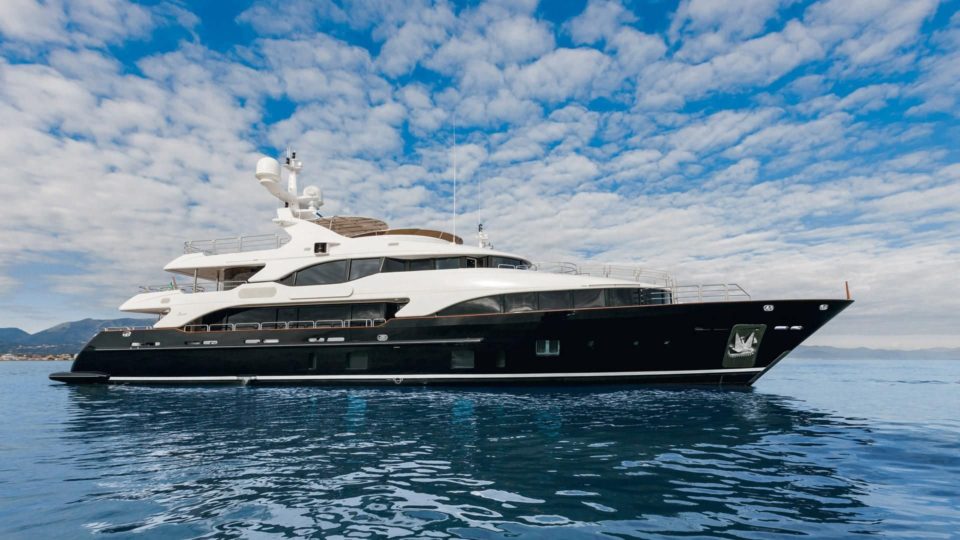
The word “yacht” generally refers to a more sophisticated craft than a boat or a ship.
Yachts can be sailed or motorized: so catamaran, monohulls, or even trimarans can also be called “yachts”.
To deserve their name, they have to be comfortable, spacious, well equipped and built with luxury in mind.
Regarding their functions, yachts are purely recreational.
They are designed for relaxation and leisure first, even though they can be suitable for long stays at sea and transatlantic crossings.
To sum up, as soon as your boat is a certain size and boasts several luxury features designed for leisure, then you can call it a yacht.
The definition of a ship
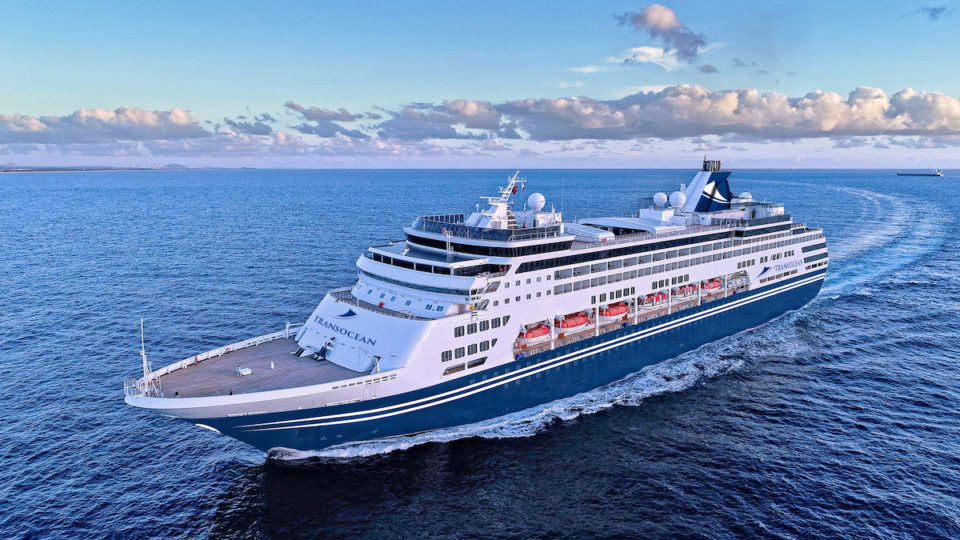
According to the Oxford dictionary, a ship is “a large boat for transporting people or goods by sea”.
The ship is associated with something larger and less fancy than a boat.
It is a “working” vessel, unlike yachts which are made for leisure purposes.
A ship usually needs a full crew to operate. A yacht might need a full crew to operate depending on its size. A boat usually implies smaller vessels and therefore most of them don’t need a crew.
Common vessels that are called “ships” include ferries, petrol tankers, or warships.
Details to look at to know if you are dealing with a boat, a yacht, or a ship
The size: one of the strong factors to identify a boat vs a yacht.
Size is one of the most determining factors to know how to call your vessel.
A boat is often expected to be smaller than a ship or a yacht. Generally, a vessel anywhere from 15-30 feet in length will be called a boat.
Starting from 15 meters (50 feet), private luxury recreational crafts can be considered yachts.
Starting from 24 meters (79 feet), you are entering the superyachts area.
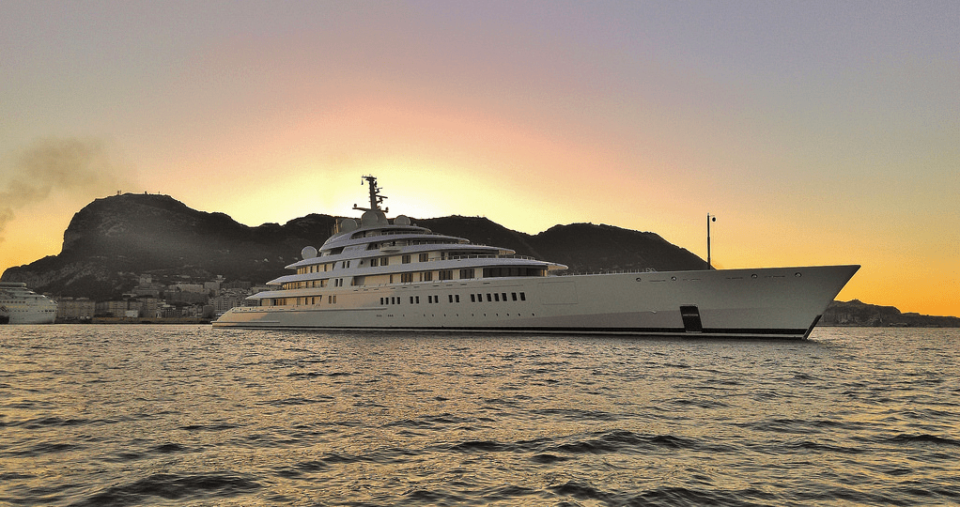
Above, 50 meters can start talking about mega yachts. Obviously, there is no upper limit to mega yachts. Currently, Azzam, the world’s biggest yacht is 180 meters long (590 feet).
So when it comes to differentiating between boat and yacht, size does matter.
But size alone isn’t enough to know the sort of vessel you are dealing with.
The function of a yacht vs a boat isn’t the same
The main function of its vessel is one of the easiest ways to recognize a boat from a ship or a yacht.
Boats can be used for both leisure and business (fishing, day trips, police, …) depending on their size and options.
On the other hand, a yacht has a purely recreational function. Unlike a “boat”, it can be used for long voyages on oceans thanks to its larger size, better propulsion, advanced electronics, guidance, and safety equipment, but especially thanks to its comfort. Yachts can protect passengers from bad weather and the comfortable cabins can accommodate several passengers for long stays. Yachts are also often available for charter with a staff taking care of the guests at a high standard of comfort.
Ships primarily have commercial functions. It can be forwarding freight, crossing the sea with thousands of people on board, or going on a warzone with a unit and its material.
To add to the confusion, some mega yachts such as Christina O could be called ships due to their initial function or their size.
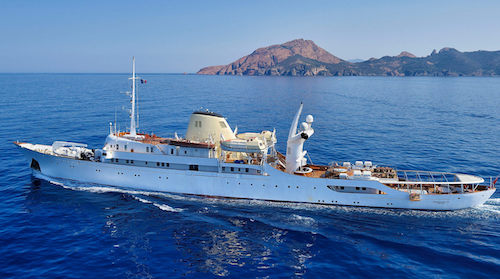
Besides these exceptions, it’s quite obvious to recognize a yacht from a boat or a ship simply by its size and the luxury of its amenities.
The luxury on board makes it a yacht or a boat
A yacht is a recreational vessel designed with luxury and comfort in mind.
The facilities, be it furniture, rooms, living spaces, safety equipment, and navigation systems are all luxurious on a yacht.
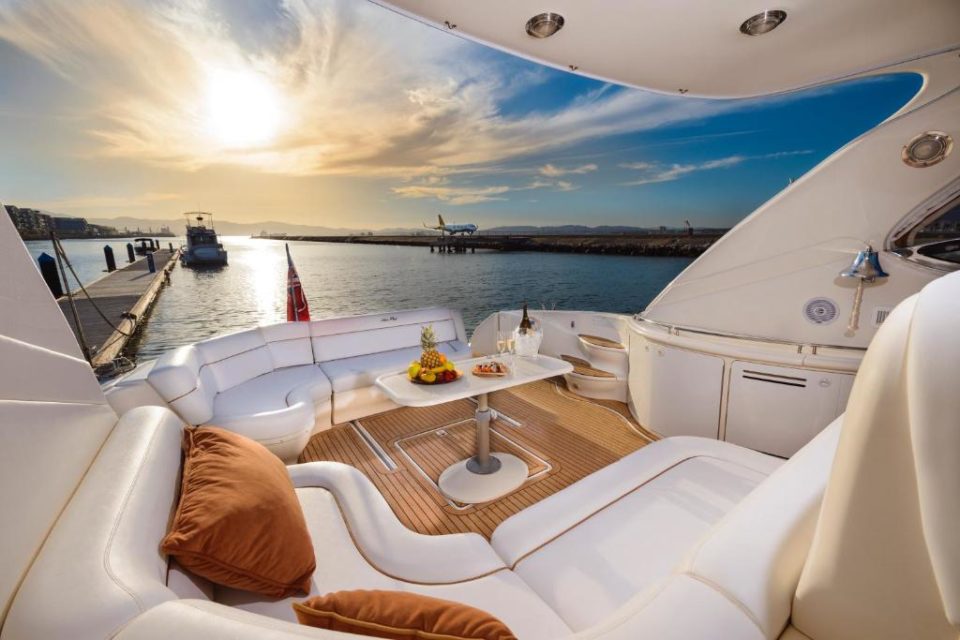
The notion of space is often very important to feel comfortable on board, even for long cruises. The largest and most luxurious yachts have various spaces such as beaches, sundecks … to make life on board as comfortable as on land, if not more.
To make it simple, if a vessel is luxurious, then more often than not, it’s a yacht.
Check out all our luxury yachts here.
The propulsion of the vessel can determine whether it’s a yacht or a boat
A boat can be rowed, propelled with its sails, or with one or several engines.
Motorized small boats can have impressive speed on the water thanks to their lightweight, but their engines are usually less powerful and sophisticated than yacht engines.
Some boats can sail long-distance when they are well equipped, such as solar panel, water maker etc.
On the other hand, equipment on yachts make them able to operate over very long distances, including crossing oceans.
Most ships are designed to cross the sea with safety and they are designed for this objective.
Looking at the propulsion is therefore not enough to know if a vessel is a boat, a yacht, or a ship, although it can give you a few clues.
The crew on board can tell the difference between a boat and a yacht
Commercial ships and professional boats obviously have experienced captains to sail them around the rough corners of the globe.
For yachts and leisure boats, it is less obvious.

Big yachts owners usually employ professionals to sail, but also manage the daily operations onboard. The number of enrolled crew members depends on the yacht’ size.
Usually, boats do not need a professional enrolled skipper to operate, if you know how to sail. But you can always rent a boat and hire a skipper to bring you wherever you want.
So, what should you call your vessel?
To make it simple, if your vessel is a luxury craft above 50 feet, designed for fun, recreation, relaxation, and comfort, then call it a yacht.
Anything below that size, call it a boat.
If you own a working craft rather than something recreational, especially if it’s a long vessel, then you are free to call it a ship.
But let’s be honest, nobody will blame you if you use the wrong term. You are entirely free to continue calling your canoe a yacht if you like it that way!
Read Also : How Much does it Cost to Charter a Luxury Yacht?
Starting from 50 feet (15 meters), a pleasure boat is usually considered a yacht.
Yes, a 40-feet boat can be considered a yacht if it has recreational use and a luxurious outfit. Otherwise, it is only a boat!
By definition, a ship is a large vessel that crosses oceans and other deep waters for commercial purposes. It carries cargo or passengers or performs specialized missions, such as defense, research, and fishing. So a boat becomes a ship when it is big, it weighs at least 500 tonnes or above and it has commercial use.
Private recreational boats from 33 feet are actually yachts. Luxury is also an important point once defining a yacht.
No. If the boat doesn’t have a recreational purpose, if it is below 33 feet long (10 meters), or if it is not luxurious, it is not a yacht but a boat!
RELATED ARTICLES MORE FROM AUTHOR
Luxury crewed yacht charters – frequently asked questions, luxury yachts for charter perfectly suited for 10 guests, skipper’s job and responsibilities: what you should know.
- Testimonials
- Privacy Policy
What's the difference between a 'boat' and a 'ship'?
All dictionaries try to avoid the dread lexicographic condition known as circular defining . This is when one looks up a word such as dictionary , sees that it is defined as “a lexicon ,” and, when looking up lexicon , finds that it is defined as “a dictionary.” Given that we spend a considerable amount of time avoiding this sort of defining, it may come to a surprise to some users to discover that one of the definitions for boat is “ship,” and vice versa.
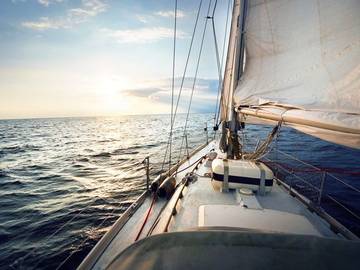
Take to the sea.
This is not actually a case of circular defining, as these seeming examples of synonymy are but one of a number of possible meanings for each word. And we do not define the words in this manner out of a desire to annoy people who love to observe the distinction between these two kinds of vessels. The reason we offer the definitions of “ship” for boat and “boat” for ship is that this is the manner in which a large number of people use the words.
‘What is the difference between a ship and a boat?’ has a good number of answers, but unfortunately most of these are not couched in the type of precise language a dictionary aims for. Sample responses to this question include ‘You can put a boat onto a ship, but you can’t put a ship onto a boat,’ ‘a boat is what you get into when the ship sinks,’ and ‘a boat is the thing you put gravy in.’
If you were to look for precision by asking this question of ten nautically-inclined people in ten different areas it is possible that you would get a wide range of answers, for the exact moment at which a boat becomes a ship varies considerably. We define ship in the following ways: “a large seagoing vessel,” “a sailing vessel having a bowsprit and usually three masts each composed of a lower mast, a topmast, and a topgallant mast,” and “boat (especially one propelled by power or sail)”. Boat has a slightly narrower semantic range, including “a small vessel for travel on water,” and “ship.”
Usage writers appear to have been warning people about these words since the late 19th century; boat appears on James Gordon Bennett’s “Don’t List” in the New York Herald , with instruction to avoid “except in describing a small craft propelled by oars.” However, the distinction between boat and ship had been observed by others well before this.
Mr. Barnes then proceeded to state the distinction between a boat and a ship, and contended that all vessels above a certain tonnage, and which were registered, came under the denomination of “ships,” inasmuch as boats had no register. — The Essex County Standard (Colchester, Eng.), 29 Oct. 1841 ”What do you think, William, is the next gradation?” ”Why, father, is there any thing between a boat and a ship?” ”We are not come to a ship yet, William; we have only spoken of such sorts of vessels as are moved by paddles or oars.” — Isaac Taylor, The Ship, or Sketches of the Vessels of Various Countries , 1834
Despite the fact that we’ve been receiving admonitions about boat and ship for over a century now, many people cheerfully insist on using boat for waterborne vessels of any size. However, few, if any, use ship to refer to small crafts. If you find that you are unable to remember the which is the larger between ship and boat it may help to sing the children’s song Row Your Boat (“row, row, row your ship ” sounds decidedly odd — small oared crafts are almost always referred to as boats ). No matter how many aphorisms we come up with, it seems unlikely that we are going to get much more specific than 'ships are bigger than boats.'
Considering that our language has hundreds of words for different kinds of things that float on the water it is somewhat odd that we should focus exclusively on the difference between only these two. Should you find yourself beset by an angry sailor who calls you out for using boat when you should have used ship you may turn and ask if they know the difference between a xebec and an umiak , a corvette and a wherry , or an argosy and a garvey (the first ones are all ships and the second ones all boats).
The fact that English usage is messy, and has contributed to a use of boat that is somewhat vague, does not mean that there aren't settings where precision is called for. For instance, when you are sailing on someone else's vessel it is polite to always employ the correct terminology. And if you find yourself at a loss about when a boat becomes a ship you should contact your local maritime authority.
Word of the Day
See Definitions and Examples »
Get Word of the Day daily email!
Games & Quizzes

Commonly Confused
'canceled' or 'cancelled', is it 'home in' or 'hone in', the difference between 'race' and 'ethnicity', homophones, homographs, and homonyms, on 'biweekly' and 'bimonthly', grammar & usage, how to use accents and diacritical marks, 31 useful rhetorical devices, how to use em dashes (—), en dashes (–) , and hyphens (-), every letter is silent, sometimes: a-z list of examples, plural and possessive names: a guide, 7 shakespearean insults to make life more interesting, pilfer: how to play and win, 8 words for lesser-known musical instruments, weird words for autumn time, much ado about ‘folie à deux’.
- Office : (772)-217-6124
- Cell : (754)-367-3768
- Email : [email protected]

- Yacht Management
- Yacht Delivery
- Yacht Crew Placement
- Yacht Charters
- Yacht Provisioning
- Yacht Restorations
- Yacht Maintenance Contracts
- Yacht General Repairs
- Yacht Electrical Installation
- Yacht Re Power
- Yacht Emergency Response
- Yacht Financial Administration
- Yacht Technical Support
- Yacht 100 hour Service
- Yacht Ozone treatment
- Yacht Linen Service
- Yacht Membership
- Affiliation
A yacht is typically larger and more luxurious than a boat. Yachts are often privately owned and used for leisure activities, while boats can be used for various purposes such as fishing or transportation. Yachts usually have cabins, living spaces, and amenities like a kitchen and bathroom, while boats may have more basic features. Additionally, yachts require a crew to operate, while boats can be operated by a single person. Overall, the main difference is in size, luxury, and purpose.

Understanding the Distinction Between a Boat and a Yacht:
1. size matters: differentiating boats from yachts.
One of the most significant differences between a boat and a yacht is their size. While there is no universally agreed-upon threshold that defines when a boat becomes a yacht, a general guideline is to consider vessels longer than 40 feet as yachts. However, this guideline may vary depending on regional and industry standards.
Boats, on the other hand, are typically smaller in size compared to yachts. They can range from small recreational vessels, such as fishing boats or speedboats, to mid-sized cruisers used for leisure activities. Boats are designed for various purposes, including fishing, water sports, transportation, and recreation.
Yachts, with their larger size, offer more luxurious and spacious accommodations. They are often equipped with multiple decks, cabins, and amenities such as swimming pools, jacuzzis, and helipads. Yachts are designed for leisurely cruising and can be privately owned or chartered for extravagant vacations.
1.1 The Distinctions in Construction
When it comes to construction, boats and yachts can be made of different materials. Boats are commonly built using materials such as fiberglass, aluminum, or wood. These materials are lightweight and cost-effective, making boats more accessible and affordable for recreational purposes.
Yachts, on the other hand, are often constructed using high-quality materials such as steel or aluminum. These materials offer increased durability and stability, making them suitable for long-distance cruises and adverse weather conditions. Additionally, yachts may feature more intricate design elements and luxurious finishes.
The construction of yachts is typically more complex than that of boats. Yachts may incorporate advanced engineering systems for propulsion, navigation, and comfort. They often boast state-of-the-art technology and amenities, elevating the overall experience for those on board.
1.2 Purpose: Differentiating Factors
Another differentiating factor between boats and yachts is their purpose. Boats are primarily used for recreational activities and water sports. They are designed to be agile, maneuverable, and efficient in covering smaller distances. Boats are popular among fishing enthusiasts, water skiers, and day cruisers.

Yachts, on the other hand, are associated with luxury and leisure. They serve as private or charter vessels for extended cruising or extravagant vacations. Yachts offer a range of amenities and services, including fine dining, entertainment areas, and spacious living quarters. They are designed to provide a luxurious and comfortable experience for those on board.
The purpose of a yacht extends beyond recreation and water sports. Yachts can also be used for business meetings, corporate events, and even hosting parties and weddings. Their larger size and amenities make them suitable for hosting gatherings and creating memorable experiences.
2. Legal and Regulatory Considerations: Licensing and Flagging
Aside from size and purpose, there are also legal and regulatory factors that differentiate boats from yachts. These factors include licensing requirements and the process of flagging the vessel.
In many jurisdictions, boats do not require specific licensing if they are used for recreational purposes. However, regulations may vary, and individuals should familiarize themselves with their local laws and requirements regarding boat operation and licensing.
Yachts often fall under stricter regulations due to their size and commercial potential. Captains and crew members operating yachts may be required to hold specific licenses and certifications, especially when operating in international waters. The licensing requirements may include qualifications in navigation, safety procedures, and emergency response.
An additional consideration for yacht owners is the process of flagging the vessel. Flagging refers to registering the yacht under the flag of a specific country. The chosen flag state will determine the legal, regulatory, and tax implications for the yacht owner. The choice of flag may have implications on the yacht’s operational restrictions, crew requirements, and taxation obligations.
2.1 The Importance of Flagging
Flagging is an essential process for yacht owners as it establishes the legal status and nationality of the vessel. The choice of flag also affects the yacht’s ability to navigate certain waters, enter ports, and comply with international regulations. Yacht owners often consider factors such as the flag state’s reputation, the yacht’s intended cruising areas, and the tax implications associated with flagging.

Popular flag states for yacht registration include countries such as the British Virgin Islands, Cayman Islands, Malta, and the Marshall Islands. These flag states offer favorable regulations, tax incentives, and a well-established yacht registration process.
3. Price and Ownership: Financial Considerations
Price and ownership are significant factors when distinguishing between boats and yachts . The cost of a vessel is influenced by various factors, including size, construction materials, amenities, and brand reputation.
Boats, being smaller and simpler in design, are generally more affordable than yachts. The price range for boats can vary widely, ranging from a few thousand dollars for small recreational boats to several million dollars for high-performance or luxury boats.
Yachts, due to their larger size, luxurious amenities, and high-quality construction, can have significantly higher price tags. The cost of purchasing a yacht can range from several hundred thousand dollars to several hundred million dollars, depending on factors such as length, brand, customization, and onboard features.
3.1 Ownership and Maintenance Costs
Ownership costs also differ between boats and yachts. Boats, especially smaller recreational vessels, generally have lower maintenance costs. They require less fuel and typically have fewer systems and amenities to maintain.
Yachts, as more complex and larger vessels, have higher ownership and maintenance costs. Fuel expenses can be significant due to their size and engine power. Additionally, the maintenance and servicing of advanced systems, luxury finishes, and amenities contribute to the overall cost of yacht ownership.
Other cost considerations for yacht owners include crew salaries, marina fees, insurance, and necessary periodic surveys and certifications. Yacht owners must also allocate a budget for ongoing maintenance and unforeseen repairs.
Exploring Different Dimensions: Performance and Usage
While the above sections cover significant aspects of the distinction between boats and yachts, it is important to recognize that there are multiple dimensions to consider when comparing the two. Performance and usage are two such dimensions that shed further light on the differences.

1. Performance: Speed, Efficiency, and Maneuverability
Performance is a crucial factor to differentiate between boats and yachts. Boats, particularly those designed for specific activities such as fishing or water sports, prioritize speed, agility, and maneuverability. These vessels are typically equipped with powerful engines and have hull designs that optimize speed and stability.
Yachts, while capable of decent speeds, prioritize comfort and stability over speed alone. They are built to handle longer voyages and adverse weather conditions while providing a smooth and comfortable experience for those on board. Yachts have a more balanced design that focuses on factors such as fuel efficiency, seakeeping, and reduced noise and vibration levels.
1.1 The Role of Hull Design
The design of the hull significantly impacts the performance of both boats and yachts. Boats often have planing hulls, which allow them to rise and glide on top of the water at high speeds. These hulls feature a flatter bottom, allowing the boat to gain speed and maneuver easily.
Yachts, depending on their purpose, may have different types of hull designs. Displacement hulls are commonly found on larger yachts and prioritize fuel efficiency and stability. These hulls move through the water instead of planing on top of it. Yachts designed for higher speeds may have semi-displacement or planing hulls, allowing for a balance between efficiency and speed.
2. Usage: Recreational and Commercial Applications
The usage of boats and yachts varies depending on their design and capabilities. Boats are predominantly used for recreational purposes and are associated with activities such as fishing, water skiing, wakeboarding, and day cruising. They are versatile vessels that cater to a wide range of recreational needs and are often used for personal enjoyment and water-based sports.
Yachts , while also used for recreational purposes, offer a broader range of applications. They are commonly chartered for leisurely vacations, providing a luxurious experience for guests. Additionally, yachts can be used for corporate events, business meetings, and even as venues for weddings and parties. Their larger size and amenities allow for a more versatile and multifunctional experience.
2.1 Commercial Aspects of Yachts
Yachts can also be involved in commercial applications beyond recreational charters. Some yachts are used as research vessels, expedition platforms, or even as floating hotels for major events or conferences. These commercial applications showcase the versatility and adaptability of yachts beyond their traditional recreational role.
In summary, while boats primarily serve recreational purposes, yachts offer a broader range of applications, including luxury vacations, corporate events, and commercial ventures.

In conclusion, while the terms “boat” and “yacht” are often used interchangeably, there are clear distinctions between the two. These distinctions include size, construction , purpose, legal considerations, price, ownership costs, performance, and usage. Understanding these differences allows individuals to make more informed decisions when it comes to choosing the right vessel for their needs, whether it be a boat for recreational activities or a yacht for luxurious cruising and hosting memorable experiences.
Key Takeaways:
- A boat refers to any small or medium-sized watercraft used for recreational activities or transportation.
- A yacht, on the other hand, is a larger, more luxurious vessel typically used for leisure and pleasure.
- The size of a boat is generally smaller, while a yacht is much larger and can have multiple decks.
- Boats are commonly used for fishing, watersports, and short trips, while yachts are designed for longer cruises and often equipped with luxurious amenities.
- In terms of cost, boats are generally more affordable, while yachts can be quite expensive to purchase and maintain.
Frequently Asked Questions
Boats and yachts are both types of watercraft, but there are differences that set them apart. Below are some frequently asked questions about the difference between a boat and a yacht:
What distinguishes a boat from a yacht?
The main distinction between a boat and a yacht lies in their size and purpose. A boat is generally smaller and designed for recreational activities such as fishing, water sports, or leisurely cruising. On the other hand, a yacht is larger and often built for luxury, comfort, and long-distance travel.
While the specific length requirement may vary, a vessel is typically considered a yacht if it exceeds 40 feet in length. Boats, on the other hand, can range from small dinghies to medium-sized pleasure crafts.
Do boats and yachts have different features?
Boats and yachts generally have similar components and functionalities, but yachts often boast additional amenities and features. Yachts are equipped with luxurious cabins, spacious decks, multiple lounging areas, and often include amenities such as swimming pools, Jacuzzis, and even helipads. Boats, while still providing comfort and functionality, may have a more simplistic design and fewer luxurious extras.
It’s important to note that there are varying sizes and types of boats and yachts, so features can differ greatly depending on the specific vessel.
In summary , the main difference between a boat and a yacht lies in their size and purpose. A boat is a broad term that encompasses various types of watercraft, often used for recreational activities or transportation. On the other hand, a yacht refers to a larger, more luxurious vessel that is typically used for leisure and pleasure.
Boats are generally smaller in size and have a simpler design compared to yachts. They are often used for fishing, water sports, or cruising in inland waters. Yachts, on the other hand, are larger and more extravagant, often featuring luxurious amenities and accommodations. They are designed for extended stays at sea, offering a comfortable and lavish experience for their owners and guests.
Yacht vs. Ship: What's the Difference?
Key Differences
Comparison chart, primary use, crew requirements, design focus, yacht and ship definitions, what is a yacht primarily used for, why are ships essential for global trade, how does a ship differ from a yacht in terms of size, is every luxury boat considered a yacht, how are ships powered, can a ship be used for leisure, is yacht racing a popular sport, how are ships navigated, can yachts cross oceans like ships, what type of crew does a yacht require, why are ships crucial for naval defense, how is the speed of yachts compared to ships, are ships and yachts subject to maritime laws, do yachts have classifications, what's the largest type of yacht, can ships be privately owned like yachts, how long can ships stay at sea, what amenities can be found on luxury yachts, can yachts be chartered, how are ships built to withstand rough seas.

Trending Comparisons

Popular Comparisons

New Comparisons

What’s the Difference Between a Boat and a Ship?
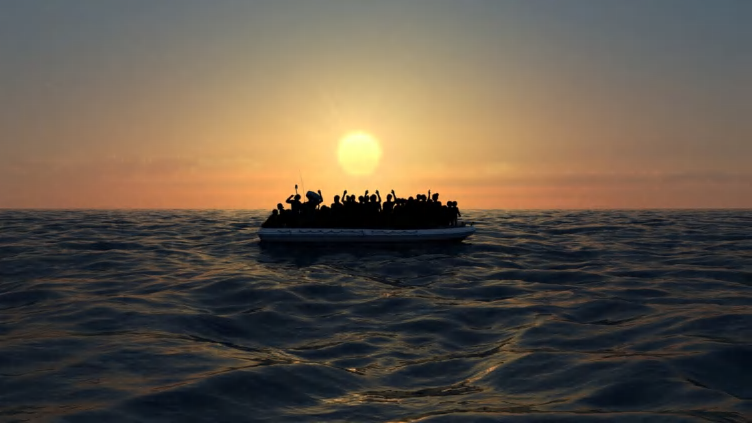
The Supreme Court ruled last week in the case of Fane Lozman vs the City of Riviera Beach, Florida . They decided that Lozman’s 60-foot, two-story, motorless, rudderless floating home was not a boat or a vessel, and hence should not have been seized under maritime law and destroyed by the city.
With the line between house and boat a little bit clearer, reader Steve asked us to clarify something else: “What defines a boat , versus a ship ?”
One of the quickest ways to reveal yourself as a landlubber is to refer to a ship as a boat, but there’s no absolute distinction between the two, and even experienced mariners rely on local custom and usage to differentiate them.
Back in the Age of Sail , a ship was pretty well defined as a vessel with three or more square rigged masts. As different methods of power generation replaced wind and sail, the ships of old became more specifically known as “sailing ships,” and the usage of ship broadened to cover a wide, ill-defined variety of vessels.
One thing that sets a ship apart from a boat is size. According the U.S. Naval Institute, a boat, generally speaking, is small enough to be carried aboard a larger vessel, and a vessel large enough to carry a smaller one is a ship. Or, as Steve says his Navy Lieutenant father put it to him, “You can put a boat on a ship, but you can’t put a ship on a boat.”
Now, this Naval convention is a good rule of thumb most of the time, but there are a few exceptions, among both naval and civilian vessels. Some yachts, ferries, tug boats, fishing boats, police boats, etc. can carry small lifeboats or dinghies, but they usually don’t graduate to ship status because of that. On the other hand, a large container ship or the USS Cole can be carried aboard an even bigger ship without getting demoted to a boat.
The U.S. Navy seems to want to have it both ways with their submarines. One component of each vessel’s official name is USS — that is, United States Ship —but seamen, the Naval Institute says, usually refer to submarines in general as boats, regardless of size.
Another factor the Naval Institute considers is the vessel’s crew, command, and use. If it has a permanent crew with a commanding officer, it’s usually a ship. If it’s only crewed when actually in use and has no official CO, then you’re probably dealing with a boat. Ships are also usually intended and designed for deep-water use and are able to operate independently for long periods of time. Boats, meanwhile, lack the fuel and cargo capacity for extended, unassisted operation.
Again, though, there are some exceptions in actual usage. Most commercial fishing vessels, for example, are large and can go out alone on the open ocean for weeks at a time. They’re almost always called boats, though, and rarely “fishing ships.”
Without any hard and fast rules about boats and ships, we humbly suggest another loose guideline that will ingratiate you to the captain of any sort of vessel: Call it whatever the skipper wants you to call it.

Boat Vs Ship
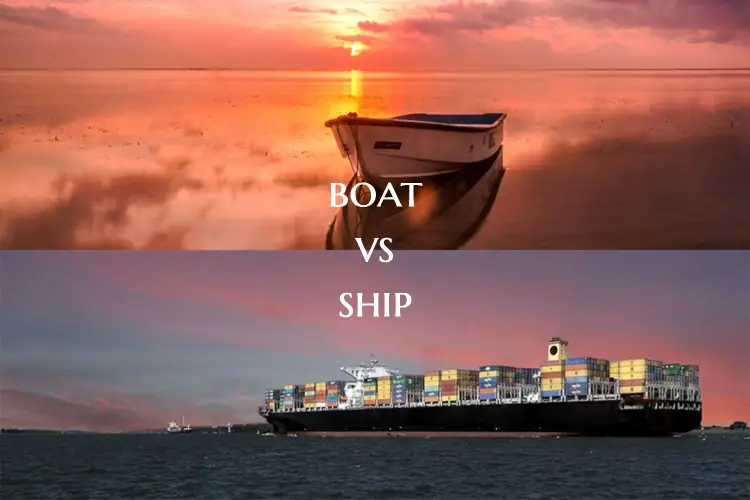
Boat vs Ship. What’s the difference between a boat and a ship? After all, both – boat or ship can be used to ferry people and cargo. If this question has also bugged you, this article will try to make the difference clear to you.
Archaeological excavations have led to the discovery of log boats that were built some 7000-9000 years ago. Near Kuwait, a 7000-year-old boat constructed from reeds and tar was found. Ancient Egyptians knew how to use planks of wood to make a ship hull as since early as 3000 BC. They were able to use reeds and grass to keep the planks together. In his books the Greek geographer Agatharchides wrote of ship faring being popular among early Egyptians.
With the onset of the Renaissance navigational technologies improved. The carrack was further developed towards the end of the 14 th century. Now it started having towers on the bow and stern.
In the 15 th century, the caravel was introduced which could sail closer to the wind and became very popular. In the 16 th century, galleons started using freeboard and free ports. The English made some modifications in their vessels to maximize firepower. This came in very handy in their victory against Armada in 1588.
The ship of the line became the most prominent naval ship of the Europeans. At 56m it had seventy-four guns and was capable of carrying a crew of 800 sailors and soldiers. In the 19 th century, the
Clippers became popular for its speed but were soon replaced by steamships that started using the Suez and Panama canals as commercial routes.
Since then the functionality and construction of boats and ships have undergone many changes where the lines differentiating them have become more and more blurred.
First, let’s know what is a boat and a ship.
A boat usually means a small vessel for travel on water. A boat is a watercraft of modest size which is meant to provide passage across water bodies. These water bodies are usually inland such as lakes and rivers.
A ship simply means a large seagoing vessel. A ship is a large watercraft that had at least three square-rigged masts and a full bowsprit. Ships may also be used on lakes, seas, and rivers. They are utilized for many activities, war, transport of people & goods, fishing, leisure, and rescue missions.
You may have heard of the phrase ‘ a ship can carry a boat, but a boat can’t carry a ship ’. But that is probably the vaguest answer that you can give to someone asking you about the difference between a boat and a ship.
Though a popular belief and a general rule of thumb say that the bigger ones are ships and the smaller ones are boats, big and small are relative terms. Some yachts, ferries, police boats, and fishing boats are capable of carrying smaller boats like lifeboats and dinghies.
This doesn’t necessarily qualify them to be called ships. At the same time, a large container ship can be carried on an even bigger ship. However, that doesn’t take away the status of the ship from the vessel that is being carried.
Hence the method of differentiating two types of vessels solely based on their size doesn’t seem to be the most logical approach.
2. Propulsion
The ‘ three-plus square-rigged masts ’ rule is in accordance with the size of the vessel to a certain extent. This is because a boat that is usually considered to be small cannot use more than three large masts. Even if it does use, it cannot benefit from it because of its size. This is because the sheer weight would slow down the ship. Such complexity would also result in inefficiency.
On the other hand, ships that are considerably bigger than boats can benefit from more sails as their total weight would be only a fraction of that of the ship.
Moreover, the ships can accommodate more crew members that would help to maintain the complex system of rigged masts.
Some boats can be propelled merely by human force through the use of oars.
A ship, on the other hand, can never be propelled by human force. It needs a dedicated engine(s) to move.
It is interesting to note that the U.S. Navy’s official naming scheme for submarines sees the use of the initials USS standing for United States Ship, irrespective of the size. Seamen are said to refer to submarines as ships regardless of the size.
This is probably a safer way of differentiating a ship from a boat as ships are generally used for navigating on the oceans and high seas.
A ship’s chief use seems to be the transportation of goods ( cargo ) through larger distances across the ocean.
People don’t usually take a ship to travel from one place to another, not when they have access to faster modes of traveling like airplanes.
Ships, on the other hand, are capable of carrying huge loads and the cost of operation is comparatively lower than airplanes.
However, they take way longer to reach a place when compared to planes.
Boats, on the other hand, are used mostly on restricted water areas (coastal and inland) like lakes and rivers. However, some boats are made such that they are operable on the seas as well. A boat can be used for a variety of things that ships are not.
Boats are mostly used for recreational purposes. These are used for all kinds of water sports. They are also used for fishing and for ferrying people and goods over short distances. Ships are mostly used for transportation (Exceptions being – Yachts & Cruise ships) .
Ships are designed keeping in mind that they need to be used in deep waters and have to be operable for longer periods of time. Compared to ships they lack the fuel and cargo capacity to independently operate for a long span of time.
4. Nature of Crew and Crew Capacity
One of the main points differentiating a boat from a ship is the nature of the crew. If a vessel has a permanent crew with a commanding officer, then you are looking at a ship.
But on the other hand, if the vessel has no permanent crew and people are hired only at the time of operation, it is safe to assume that it is a boat you are dealing with.
5. Navigation
Ships have complex systems in place for navigation with a dedicated crew to run, handle, and maintain all aspects of such equipment. This necessitated by the fact that ships have to travel across oceans and seas, under difficult weather conditions for which they need high-tech assistance.
Boats are mostly much simpler watercrafts. They are mostly used for recreational or fishing purposes for which they don’t need very complicated and specialized instruments for navigation.
6. Areas of Operation
Ships as we know by now travel great distances across the seas and other water bodies with great depth. Ships carry cargo such as goods, oil, and LNG from one end of the globe to another over high seas.
Boats operate over a smaller span of an area like rivers, lakes, or coastal areas. There are different kinds of boats for different functions.
8. Cargo and Passenger capacity
One of the biggest differentiators is that ships can carry a large amount of cargo or passengers. Like a cruise ship can easily carry a couple of thousand passengers.
Boats in contrast carry low load and passengers. A ferry boat can carry hundreds of people but most of the boats dont.
Here is a quick and easy way to differentiate between a ship and a boat. If the vessel’s captain gets offended by you calling it a ‘boat’ then probably, by all means, it is a ship, and if you don’t want to be in the captain’s black book, you might as well believe it from your heart and start calling it a ship too.
If the captain doesn’t seem to mind you calling it a ‘boat’, then it is definitely a boat.
Similar Posts
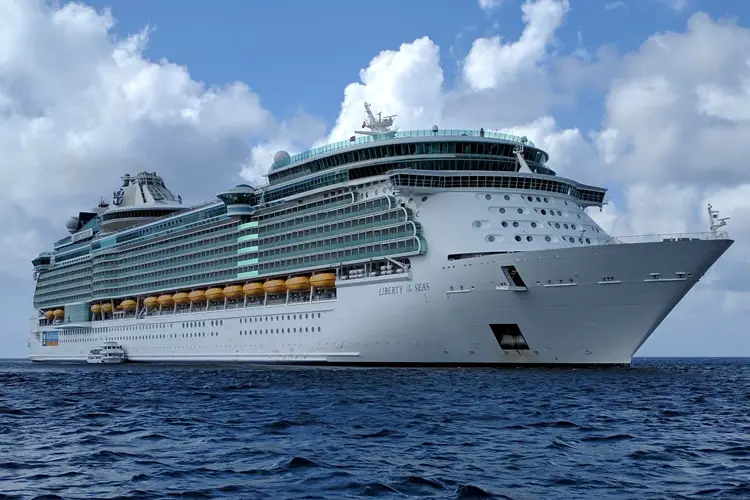
Liberty of the Seas Deck Plan
Liberty of the Seas is a Royal Caribbean International Freedom-class cruise ship which made its inaugural voyage in May 2007. Liberty of the Seas is the second ship in the Freedom-class fleet, with Independence of the Seas joining in April 2008. Here are Liberty of the Seas Deck Plan Pics courtesy: https://www.royalcaribbean.com/ Liberty of the…
![8 Interesting Suez Canal Facts [UPDATED for Ever Given] 7 8 Interesting Suez Canal Facts [UPDATED for Ever Given]](https://www.maritimemanual.com/wp-content/uploads/2019/02/suez-canal-768x512.jpg)
8 Interesting Suez Canal Facts [UPDATED for Ever Given]
Quick Suez Canal Facts Panama Canal, Volga-Don Canal, the Corinth Canal, the Grand Canal, and the Suez Canal happen to be the most famous man-made canals in the world. They are responsible for carrying out the majority of marine transportation in the most economically efficient way possible. Suez Canal has a special place in History…
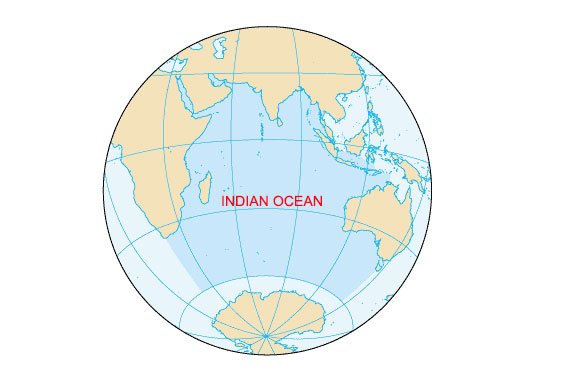
25 Amazing Facts About the Indian Ocean
The Indian Ocean is among the three major oceans of the world. It is the 3rd largest ocean on the planet after the Pacific Ocean and the Atlantic Ocean. It is also the youngest ocean among the top three oceans of the world. There are many unique facts about the ocean. It has many aspects…

20 Best Graduate Marine Engineering Institutes In India – GME Courses
What is Graduate Marine Engineering (GME)? Graduate Marine Engineering (GME) course is one of the best ways to become a marine engineer in India. A mechanical engineer can pursue a 1-year course of GME and become a marine engineer. GME is offered by around 20 institutes in India and it has become a course of…
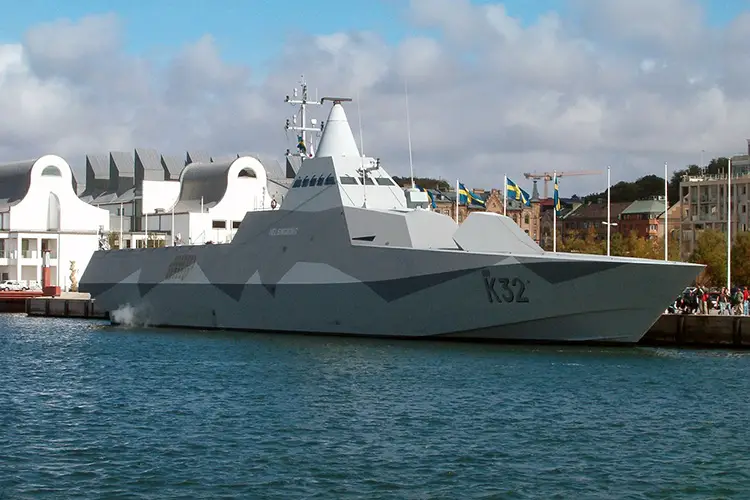
What Is A Corvette Ship?
If you are a motorhead, then the name Corvette should mean the iconic vehicle in Chevrolet’s sports car lineup – a superfast car that has been a popular name on the race tracks. It is also commonly known as the Vette. But for marine enthusiasts, Corvette is the name given to the smallest class of…
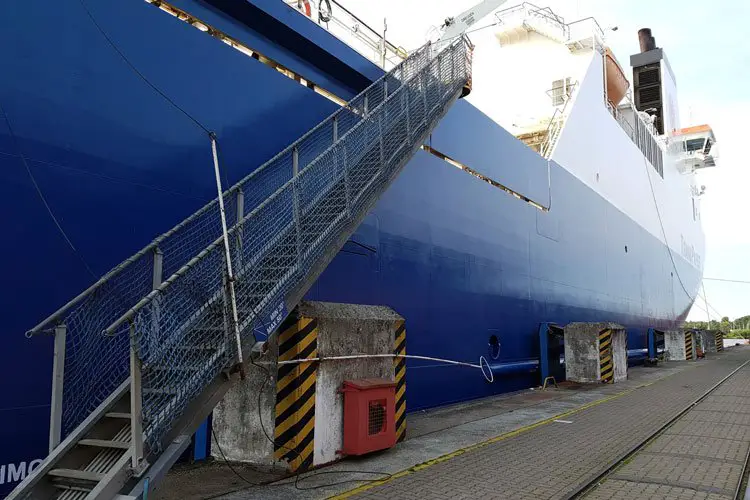
8 Types Of Gangways – Ultimate Guide
What is a Gangway? A Gangway is a passage that is used to make a way between the dock and the ship. It is a ladder or ramp type of thing which helps in giving easy access to the ship. It is used by passengers to get in and off of the ships. It is…
And yet, any US submarine officer or crew member will tell you that their commissioned vessel is a “boat” and not a “ship”. Even though some carry smaller manned subs.
In this case, it is purely a matter of US Navy convention, and not a technical definition. Submarines were originally carried by ships, not independent, and where thus “ship’s boats”. But even though that period only lasted about 30 years, the custom stuck.
The USBN Ohio is a boat, not a ship.
Good explanation. I always believed that boats are small and ships are big. That’s the only difference man!
Nice… You explained very well the difference between a ship and a boat. You covered all aspects to differentiate it.
Leave a Reply Cancel reply
Your email address will not be published. Required fields are marked *
Save my name, email, and website in this browser for the next time I comment.
This website uses cookies to improve your experience. We'll assume you're ok with this, but you can opt-out if you wish. Read More

Ship vs. Yacht — What's the Difference?
Difference Between Ship and Yacht
Table of contents, key differences, comparison chart, navigation areas, design priorities, crew requirements, compare with definitions, common curiosities, what is the primary purpose of a ship, do you need a professional crew to operate a ship, can a yacht sail across the ocean, where can ships typically dock, is a yacht considered a luxury, which is more expensive to maintain, a ship or yacht, can a yacht be as big as a ship, can ships be used for personal purposes, is a cruise ship considered a ship or yacht, which is faster, a ship or yacht, do yachts have a specific size range, share your discovery.

Author Spotlight
Popular Comparisons

Trending Comparisons

New Comparisons

Trending Terms

- UK Politics
- News Videos
- Paris 2024 Olympics
- Rugby Union
- Sport Videos
- John Rentoul
- Mary Dejevsky
- Andrew Grice
- Sean O’Grady
- Photography
- Theatre & Dance
- Culture Videos
- Fitness & Wellbeing
- Food & Drink
- Health & Families
- Royal Family
- Electric Vehicles
- Car Insurance Deals
- Lifestyle Videos
- Hotel Reviews
- News & Advice
- Simon Calder
- Australia & New Zealand
- South America
- C. America & Caribbean
- Middle East
- Politics Explained
- News Analysis
- Today’s Edition
- Home & Garden
- Broadband deals
- Fashion & Beauty
- Travel & Outdoors
- Sports & Fitness
- Climate 100
- Sustainable Living
- Climate Videos
- Solar Panels
- Behind The Headlines
- On The Ground
- Decomplicated
- You Ask The Questions
- Binge Watch
- Travel Smart
- Watch on your TV
- Crosswords & Puzzles
- Most Commented
- Newsletters
- Ask Me Anything
- Virtual Events
- Wine Offers
- Betting Sites
Thank you for registering
Please refresh the page or navigate to another page on the site to be automatically logged in Please refresh your browser to be logged in
Utah man bought cruise ship on Craigslist – now it’s sinking after $1m restoration
In may, the ship had begun to ‘sink in 13 feet of water and discharge pollution’, article bookmarked.
Find your bookmarks in your Independent Premium section, under my profile

Stay ahead of the curve with our weekly guide to the latest trends, fashion, relationships and more
A Utah man spent $1 million renovating a cruise ship he bought off Craigslist – only for it to sink.
In an interview with CNN Travel , technology entrepreneur Chris Willson admitted that he and his partner Jin Li spent 15 years renovating a 293-foot vessel called the Aurora after purchasing it off Craigslist in 2008. From a swimming pool to an indoor theater, the ship boasted many amenities and tons of space for guests, with 85 cabins.
After learning more about its history, like how it was originally named Wappen von Hamburg, built in Germany after World War II as well as being featured in the 1963 James Bond film From Russia with Love, Willson fell in love with the idea of restoring the boat to its former glory.
Willson was able to “work out a really good deal” for the boat, and set about his passion project, first docking it for a year in Rio Vista, California, then in San Francisco’s Pier 38 for three years, and was docked for a year at Herman & Helen’s Marina by Stockton, Calif. However, he ended up selling the boat in 2023 after locals took issue with the ship.
But by then, he had gotten significant renovations done to the ship, with his ultimate goal being to transform it into a museum. Over those 15 years spent renovating, he garnered over 12,000 followers on the Aurora Restoration Project’s Facebook page as well as 80,000 subscribers to the project’s YouTube channel . Well-wishers commended him on restoring the ship, with some even traveling from far and wide to visit the project in California.
“I’d gotten quite a ways. I think we had 10 areas solidly restored and refurnished meticulously,” he recalled. “These were kind of major areas. So we were pretty proud of that. So we were doing a pretty good job. We had marine engineers involved.”
Although the identity of the Aurora’s latest owner hasn’t been revealed, the US Coast Guard announced that the ship had begun to “sink in 13 feet of water and discharge pollution.”
“Extensive surveys suggest that no recoverable oil remains onboard. There were no observations of oiled wildlife throughout the response,” the U.S. Coast Guard’s press release added, noting that the City of Stockton had “hired contractors to maintain pumps within the vessel to address potential water ingress and monitor the vessel.”
According to the San Joaquin County Sheriff’s Office in a post on X , officials have determined that “the ship has suffered a hole and is taking on water and is currently leaking diesel fuel and oil into the Delta Waterway.”
The following month, Unified Command hired contractors to refloat the Aurora and remove “an estimated 21,675 gallons of oily water, 3,193 gallons of hazardous waste, and five 25-yard bins of debris.”
Since then, there’s been an ongoing dispute over the ownership of the cruise, with the city of Stockton officials claiming it had “no clear ownership.”
However, in a recent post on the Facebook group page dedicated to Aurora’s restoration project, Willson told his followers the “new owner has consistently reached out to every pertinent agency, fervently proclaiming his ownership status, and has provided unequivocal legal documentation confirming his ownership.”
Willson and Li are now searching for a new passion project, preferably for something on land, but they will always have a soft spot for the Aurora.
“It was such a well-known vessel,” Willson said. “And it had everybody’s hearts.”
Join our commenting forum
Join thought-provoking conversations, follow other Independent readers and see their replies

COMMENTS
Ultimately it comes down to this: all three of them are boats, but yachts are fancier, larger, and used for recreation, and ships are even larger, used commercially or by the navy, and are meant to cross oceans. The dividing line is sometimes thin, but generally speaking, when it comes to boats vs. ships.vs. yachts you can go by the adage " I ...
Ship vs Boat vs Yacht. In terms of size, boats are the smallest, followed by yachts, and then ships, which are the largest of the three. Boats are typically used for personal or recreational purposes, while ships are primarily employed for commercial or transportation activities. Yachts, on the other hand, cater to the luxurious and leisurely ...
In casual use, the word boat is often used to refer to any watergoing vessel, regardless of its size or how it's powered. However, large oceanfaring watercraft—those that use multiple sails or engines—are more properly called ships. In contrast, the word ship isn't commonly applied to smaller craft. The word yacht is typically used to ...
Where the vessel sails. (Photo courtesy of American Queen Voyages) I recently sailed on my first U.S. river cruise, during which a lecturer explained that boats are specifically built for inland waterways, such as lakes and rivers. "This is a boat, despite its size," she said, also noting that it carries lifeboats (which would make it a ship by ...
In general, yachts are either sailing or motor vessels used for pleasure. Yachts are often luxurious and equipped with an overnight cabin. Boats can be either propelled sail or a motor and come in varying sizes. On the other hand, ships are usually motor-powered and much larger than boats.
It also refers to a tender to a bigger boat or yacht. "Ship" is a large commercial boat, often used for distance travel and transport of goods or passengers - cruise ship, container ship, etc. "Yacht" is typically a larger boat with luxury amenities used as a recreational vessel— motor yacht, sailing yacht. "Superyacht" is a ...
A boat becomes a "ship" often once it's reached a specific size, which tends to be on the bigger side and suitable for sea travel. In most cases, ships serve as working vessels, such as transport or cruise liners. "Yachts" are also more substantial, but they're solely recreational vessels and often used for luxury purposes.
There's a popular saying that goes "a ship can carry a boat but a boat can't carry a ship.". Another popular one is that a ship leans left when it turns right. A boat leans right when it turns right. According to some definitions a ship is a vessel weighing at least 500 tons.
Besides ship and yacht, boat is another commonly used term. The definition of a boat is much more vague and open to interpretation. Boats tend to be small personal craft and only carry a few people.
This is one of the major differences between a ship and a boat. Ships have a large crew which consists of the Captain who commands the vessel, Second and Third Officers, Engineers, Cooks etc. On the other hand, a smaller boat does not need many people. 5. Cargo Capacity.
Defining 'boat' seems to be stickier than 'yacht' or 'ship.'. We hear many captains referring to their 'boat,' irrespective of size, function, or fit-and-finish. Short of being deliberately confusing, it seems as though the word boat has become a colloquialism, pet phrase, or slang term for any floating object more complicated ...
1. Size. The first key difference between a boat and a yacht is their size. A yacht is typically bigger than a boat and whilst there is no strict definition of what a yacht is, the general consensus is that if it is over 40 feet in length, it is usually considered a yacht. Boats can also vary in size, starting from small dinghies to larger ...
What is the difference between a boat and a ship? Boats and ships are two fairly similar things - with a couple of major differences. If you're thinking 'boats are smaller than ships' then you're on the right track. A boat is a small to medium sized vessel with a much smaller capacity for carrying passengers or cargo.
Definition. A boat is a watercraft of modest size designed to float or plane, to provide passage across water. A ship is a large vessel that floats on water. Types. unpowered boats, sail boats and motorboats. commercial vessels, naval ships, fishing vessels and pleasure craft.
A boat is often expected to be smaller than a ship or a yacht. Generally, a vessel anywhere from 15-30 feet in length will be called a boat. Starting from 15 meters (50 feet), private luxury recreational crafts can be considered yachts. Starting from 24 meters (79 feet), you are entering the superyachts area. Azzam Yacht, 590 ft.
The main difference between the two is that a yacht will always look and feel fancier than a boat or regular ship. If it appears and smells luxurious, given its minimum size, it is a yacht. Boats can be built for many things. But yachts are built mainly for fun and leisure.
We define ship in the following ways: "a large seagoing vessel," "a sailing vessel having a bowsprit and usually three masts each composed of a lower mast, a topmast, and a topgallant mast," and "boat (especially one propelled by power or sail)". Boat has a slightly narrower semantic range, including "a small vessel for travel on ...
Understanding the Distinction Between a Boat and a Yacht: 1. Size Matters: Differentiating Boats from Yachts. One of the most significant differences between a boat and a yacht is their size. While there is no universally agreed-upon threshold that defines when a boat becomes a yacht, a general guideline is to consider vessels longer than 40 ...
A ship's design is often more utilitarian compared to the luxury and comfort-focused design of a yacht. 5. Another notable difference between a yacht and a ship is in the ownership and operation. While yachts are generally owned by individuals or families for private use, ships often belong to corporations, governments, or large entities and ...
One thing that sets a ship apart from a boat is size. According the U.S. Naval Institute, a boat, generally speaking, is small enough to be carried aboard a larger vessel, and a vessel large ...
Cargo and Passenger capacity. One of the biggest differentiators is that ships can carry a large amount of cargo or passengers. Like a cruise ship can easily carry a couple of thousand passengers. Boats in contrast carry low load and passengers. A ferry boat can carry hundreds of people but most of the boats dont.
Key Differences. A ship and a yacht are both waterborne vessels, but they serve distinctly different purposes and have varied features. Ships are generally built and designed for cargo transportation, passenger transport, or specialized tasks in the deep waters. On the other hand, yachts are more oriented towards personal or recreational use ...
A 100-foot yacht docked in Marina del Rey in Los Angeles became engulfed in flames on Wednesday night due to fireworks and live ammunition on the ship. ... from the large boat, named The Admiral ...
Utah man bought cruise ship on Craigslist - now it's sinking after $1m restoration. In May, the ship had begun to 'sink in 13 feet of water and discharge pollution'